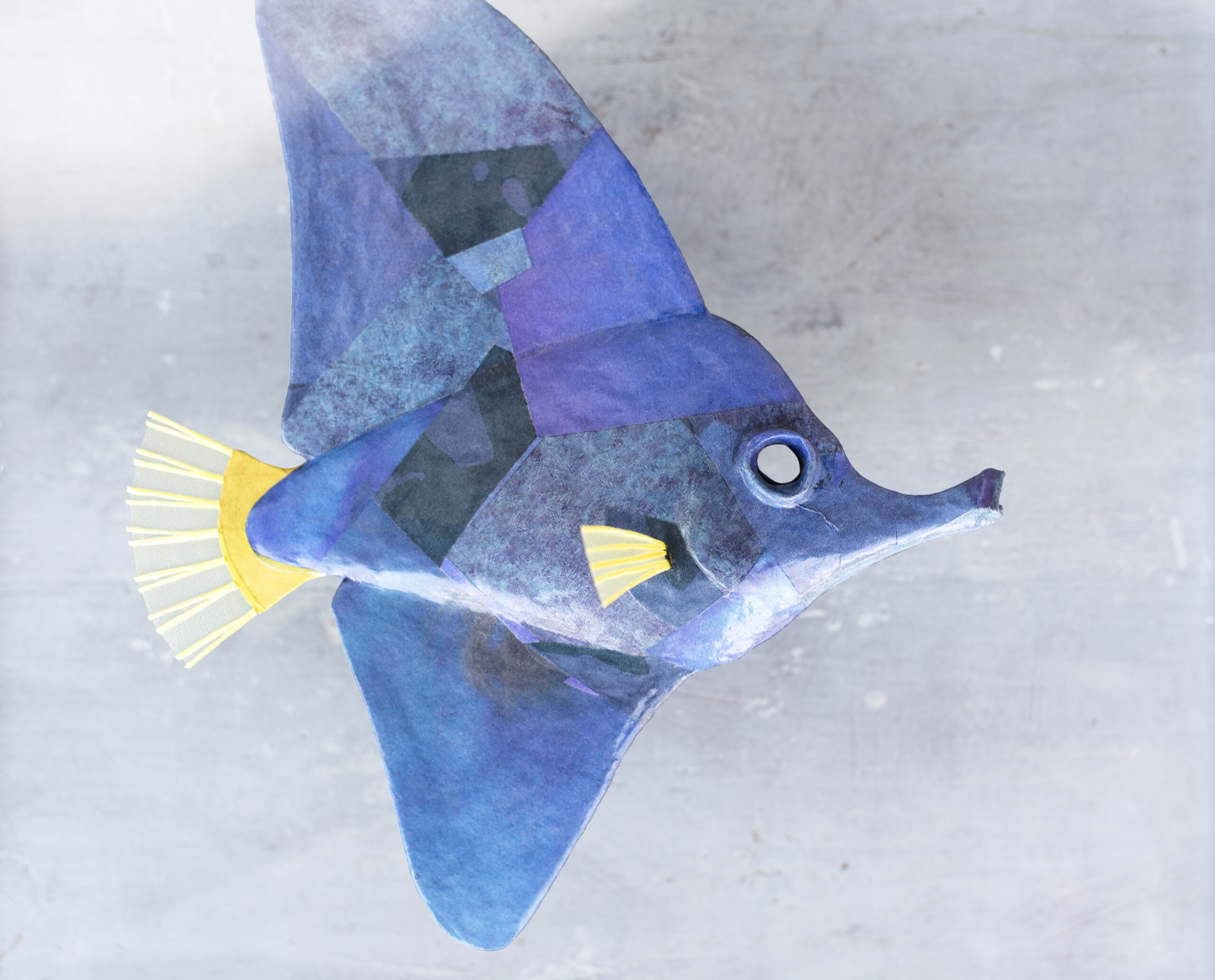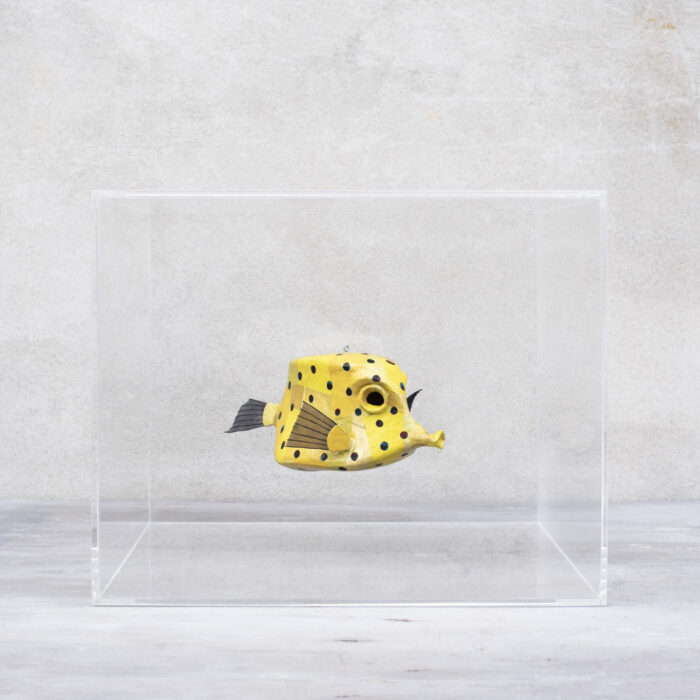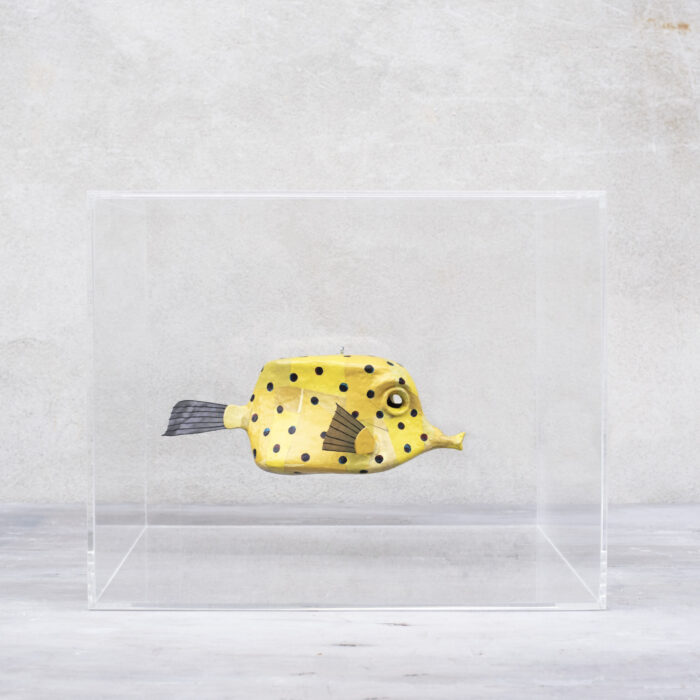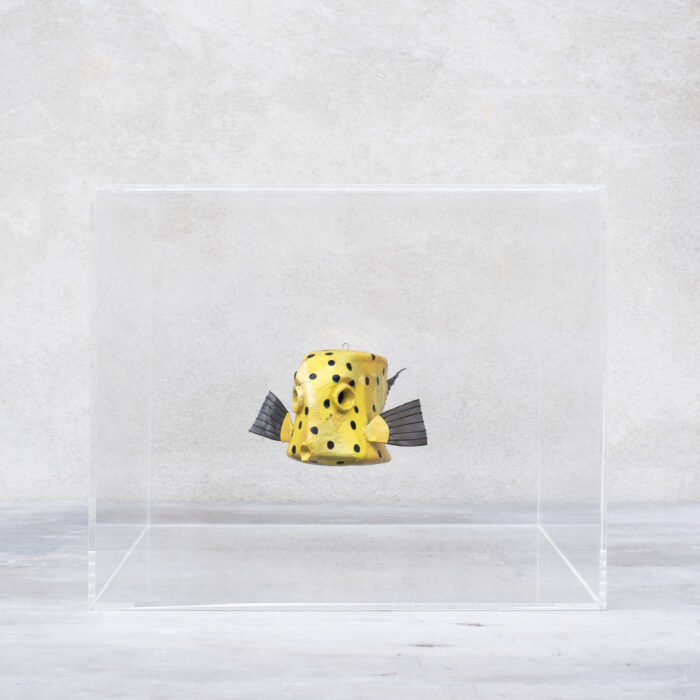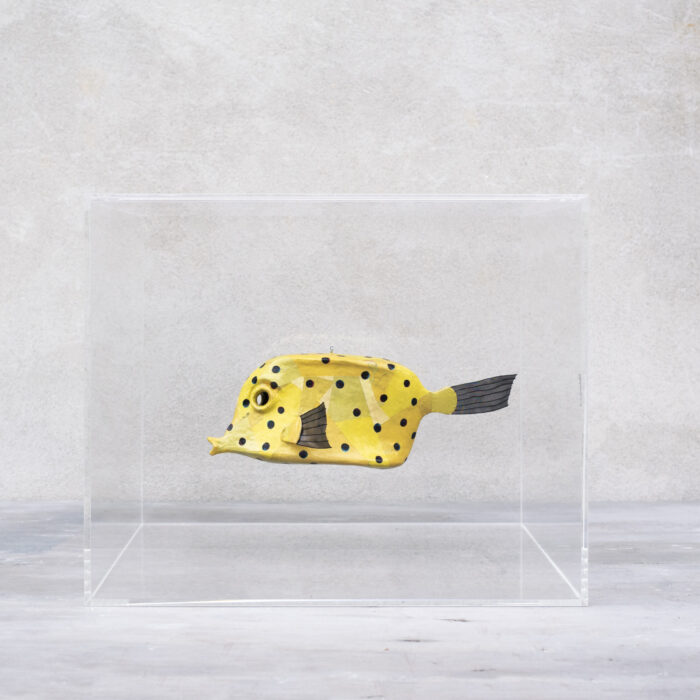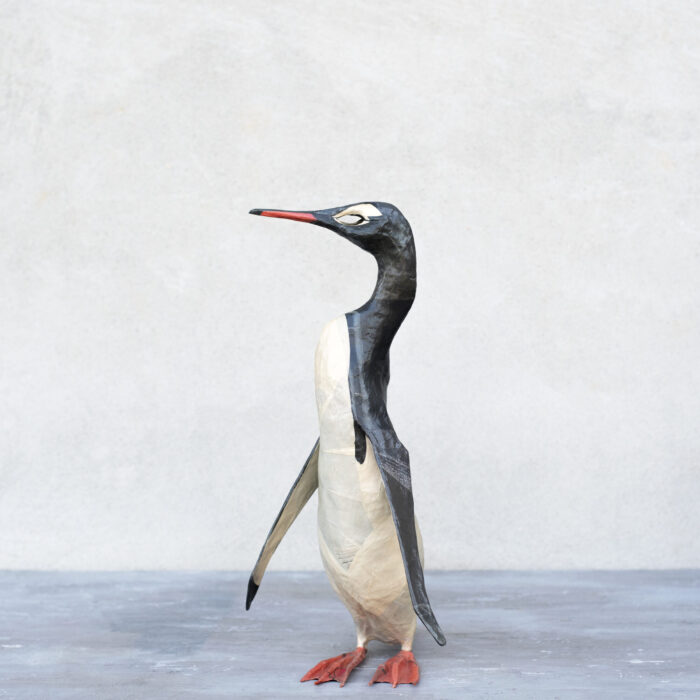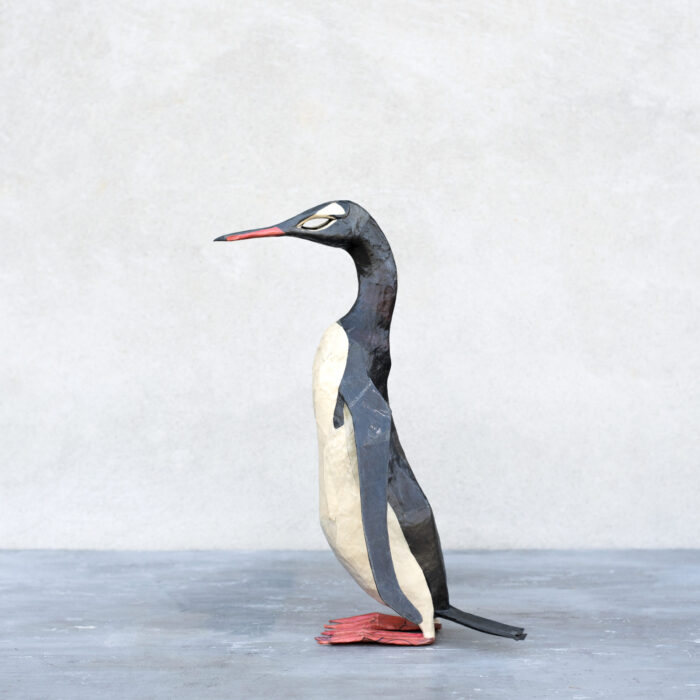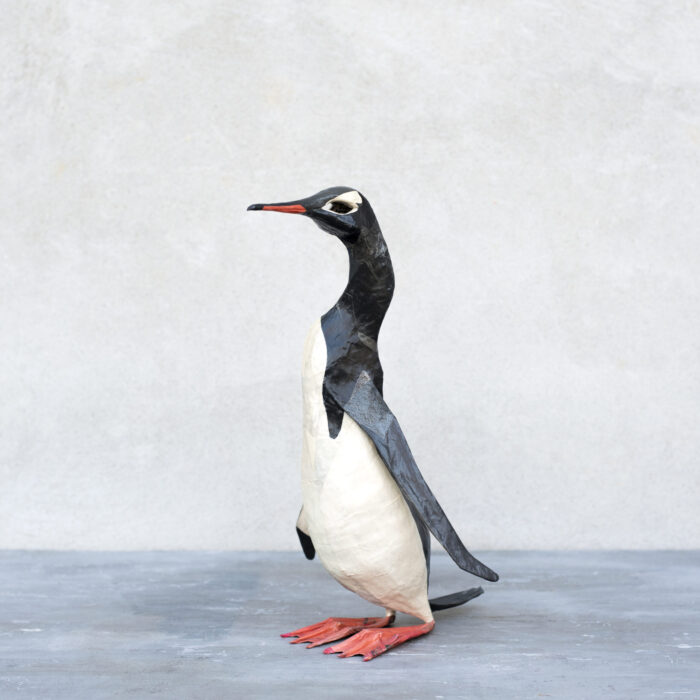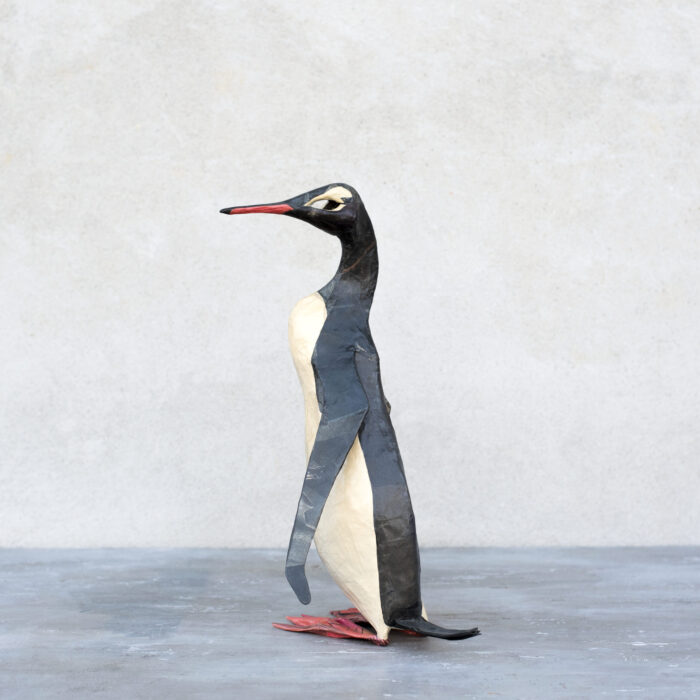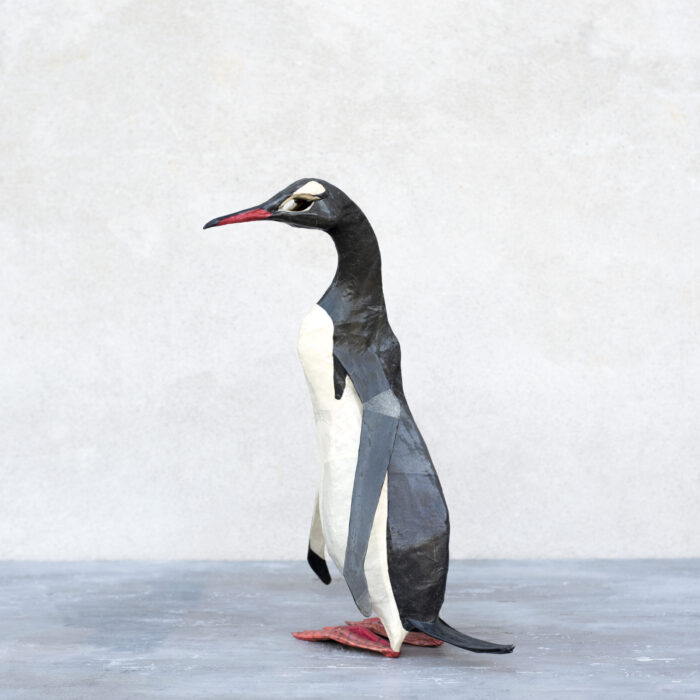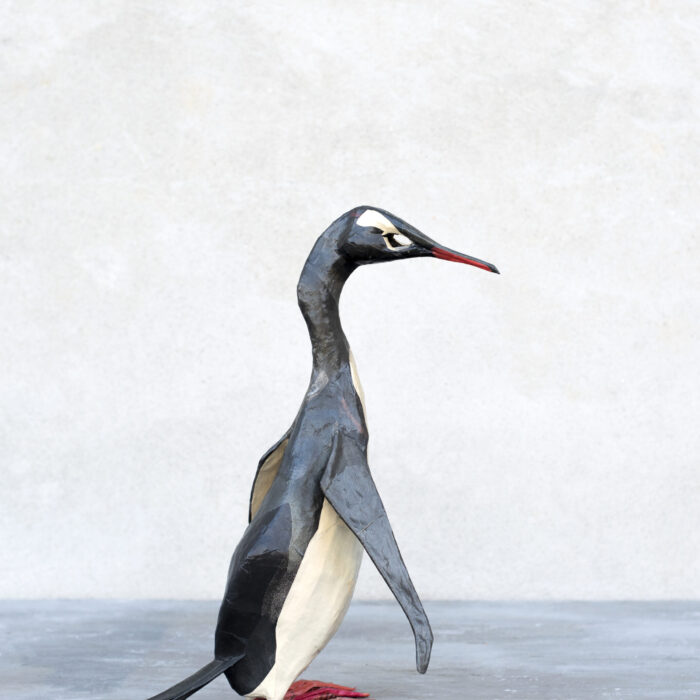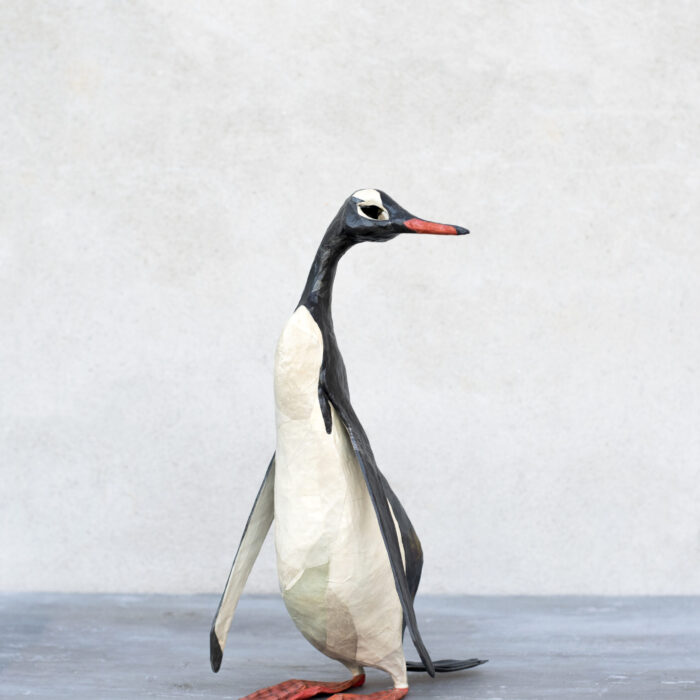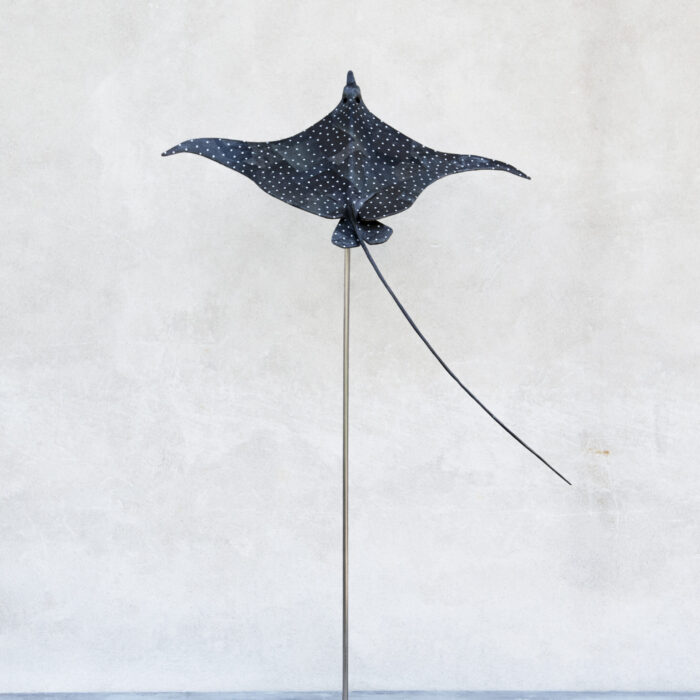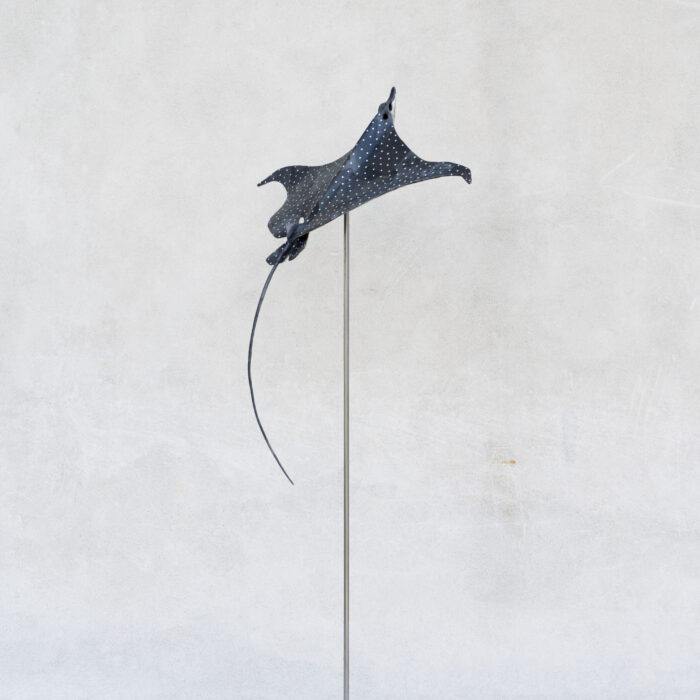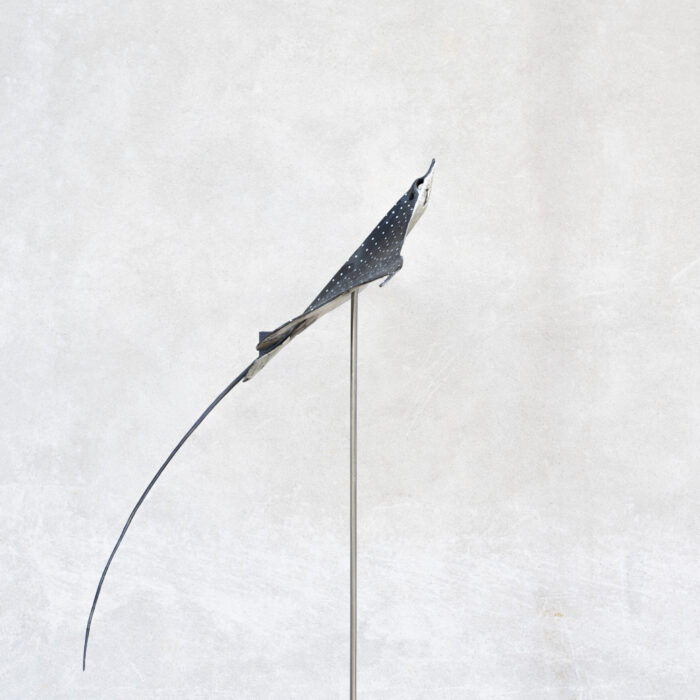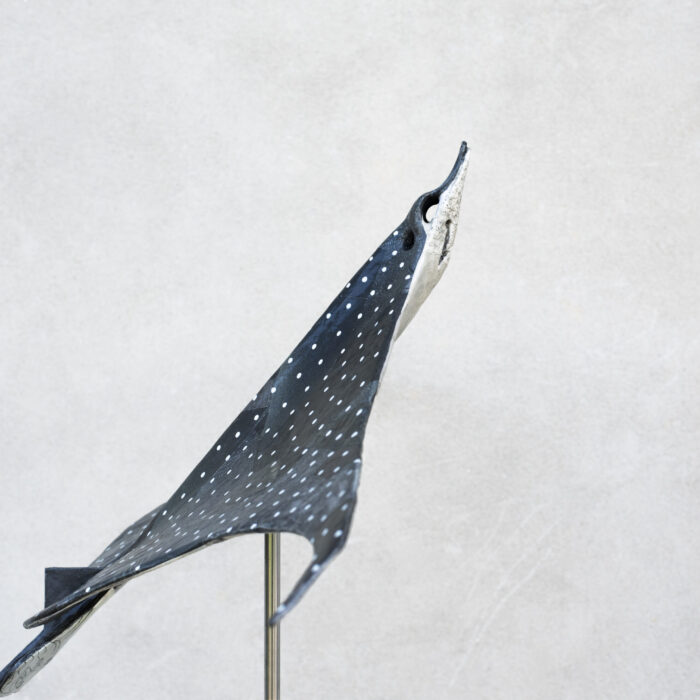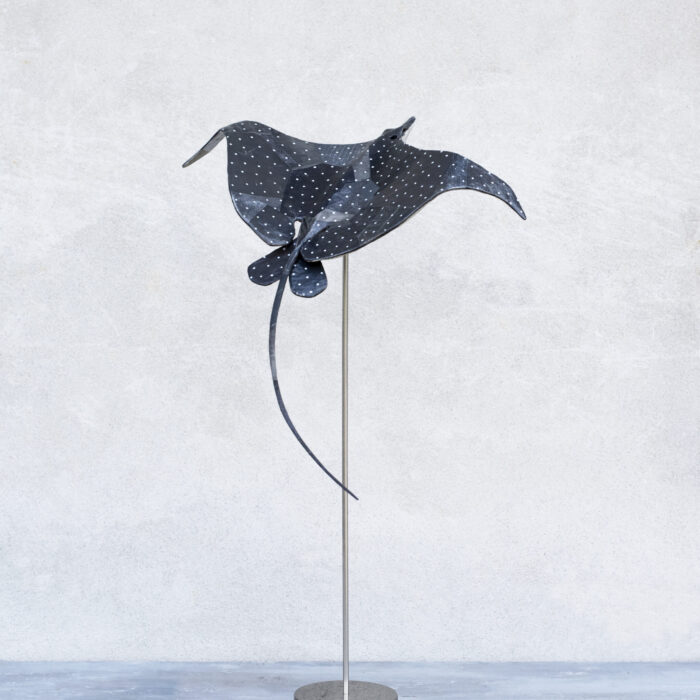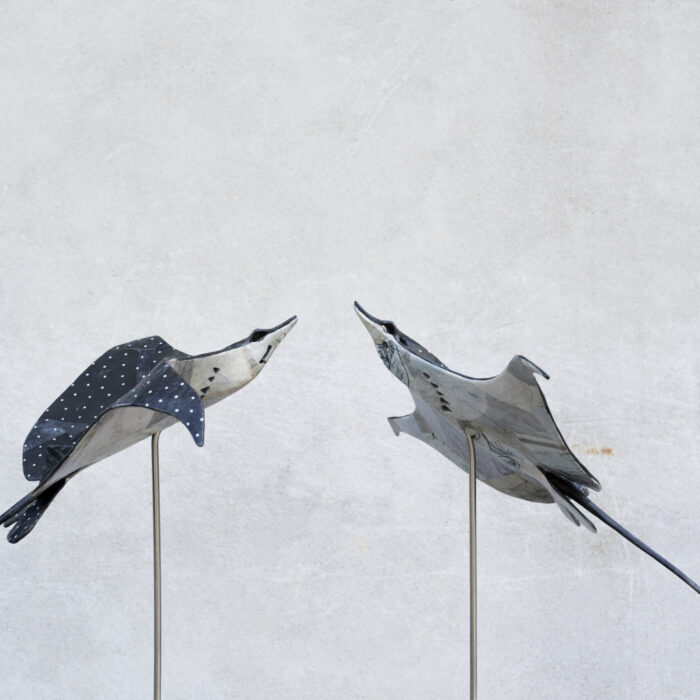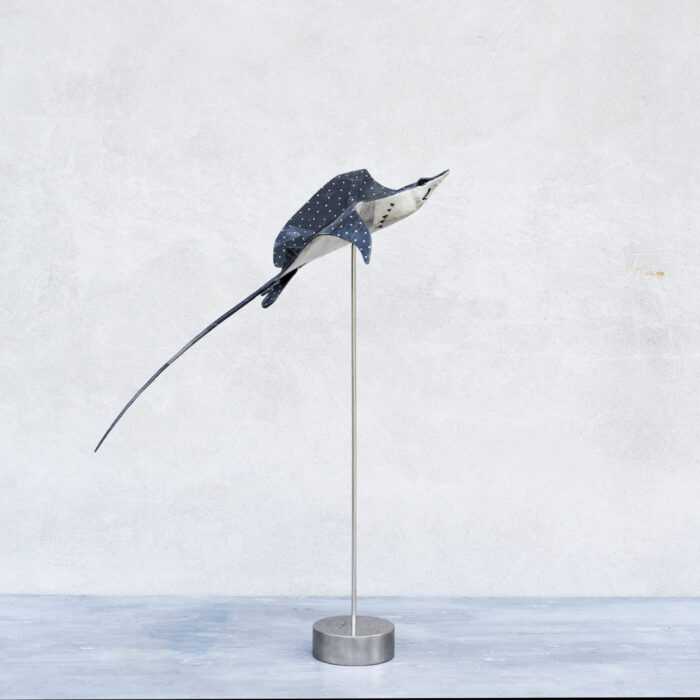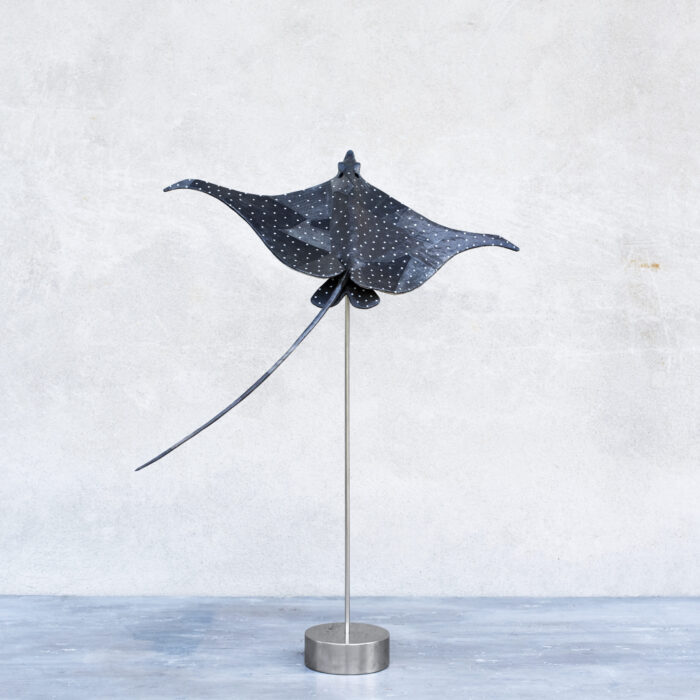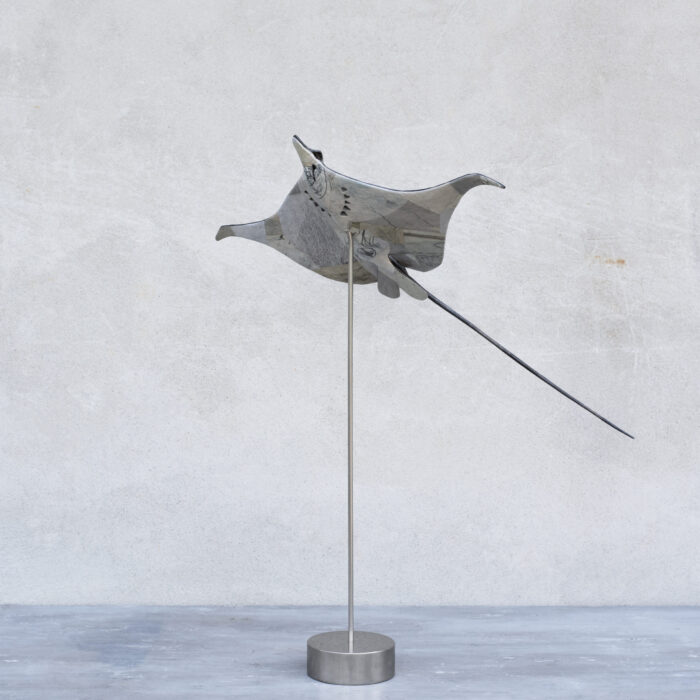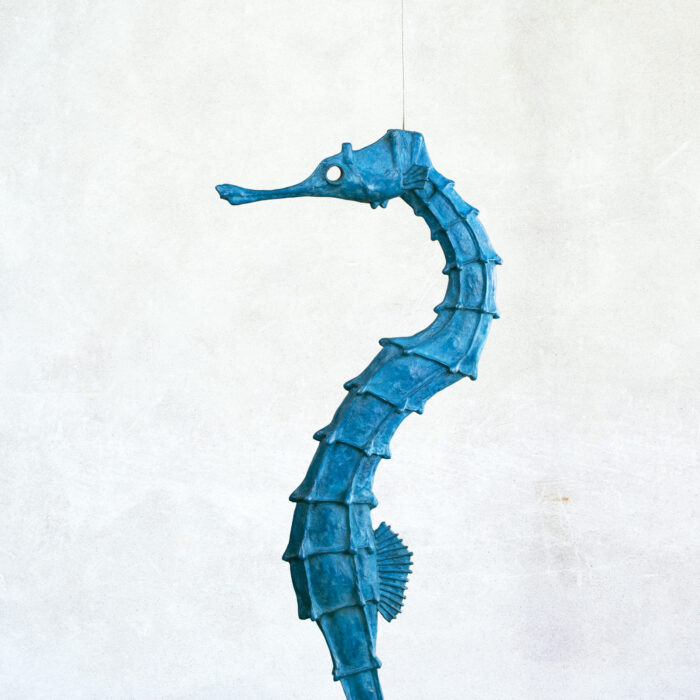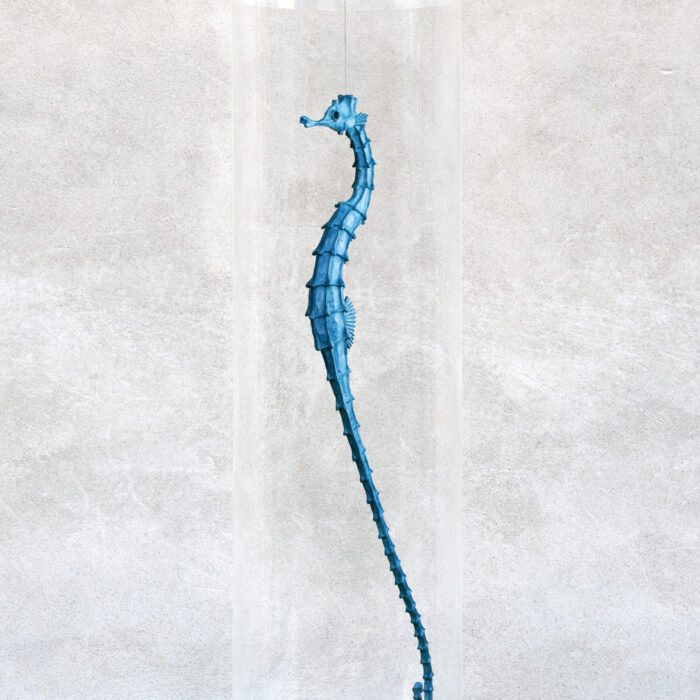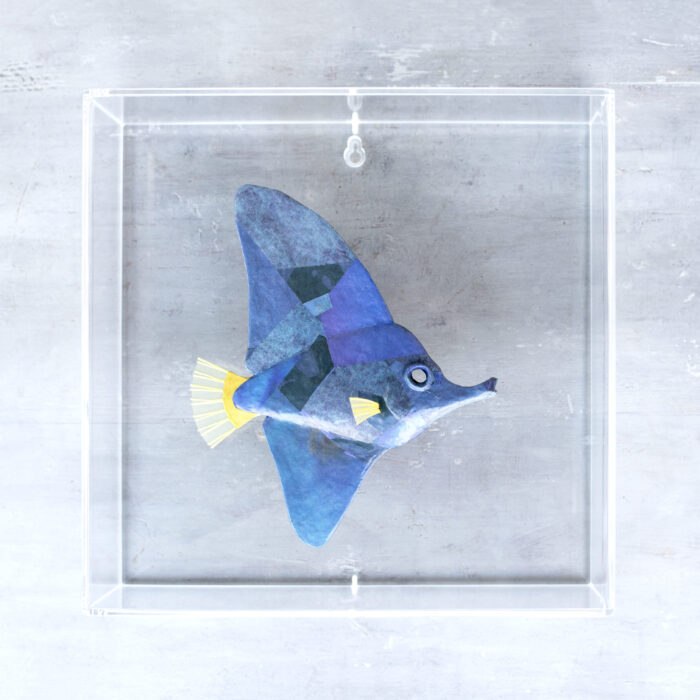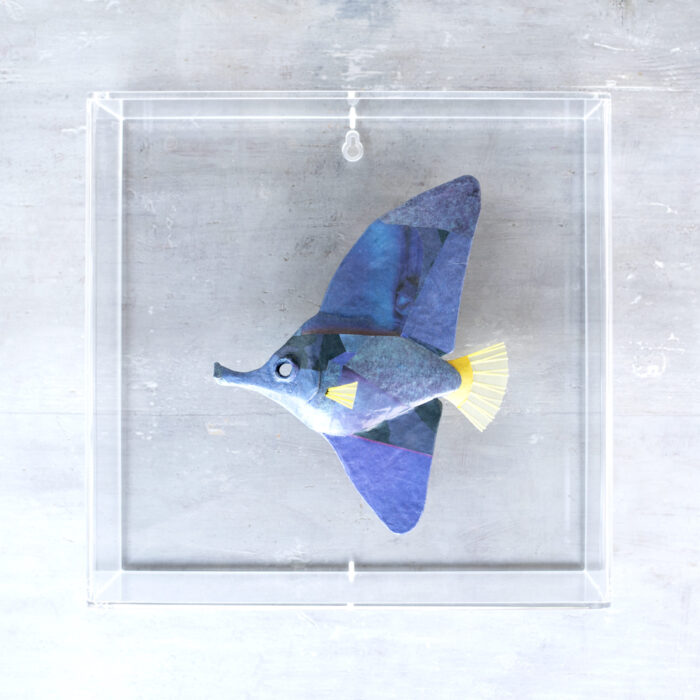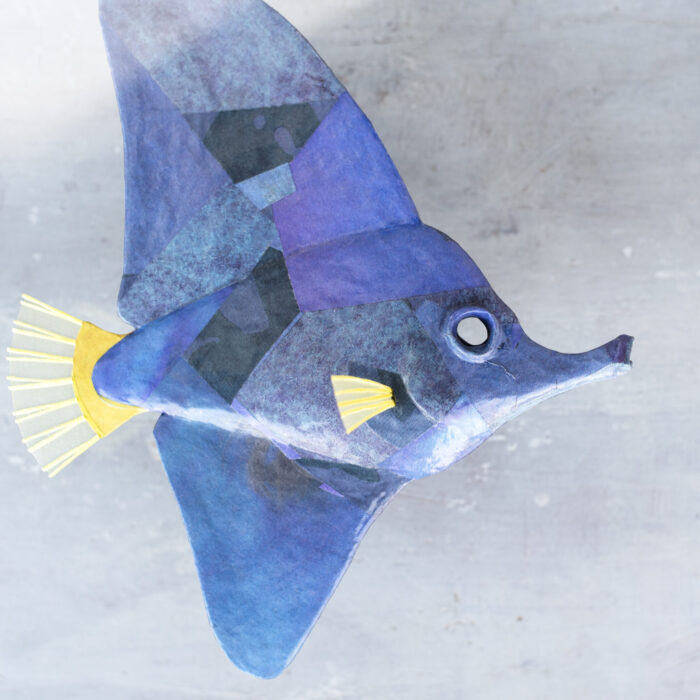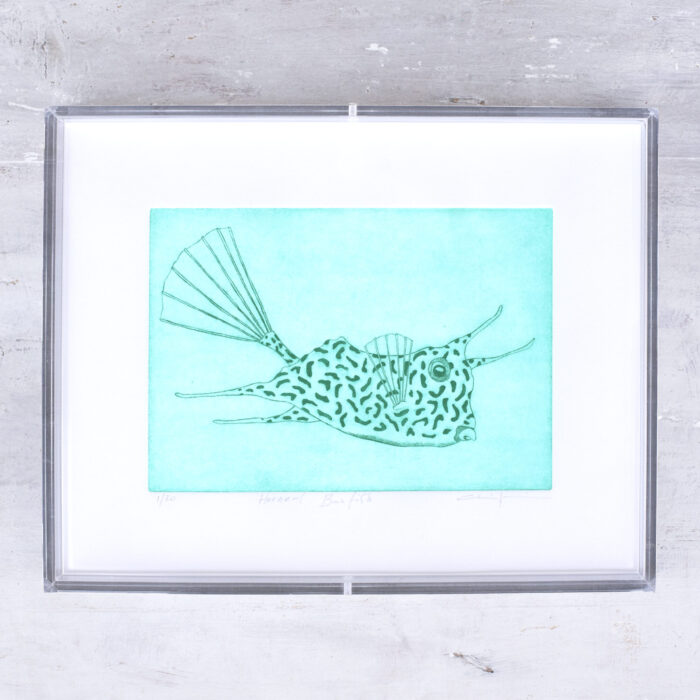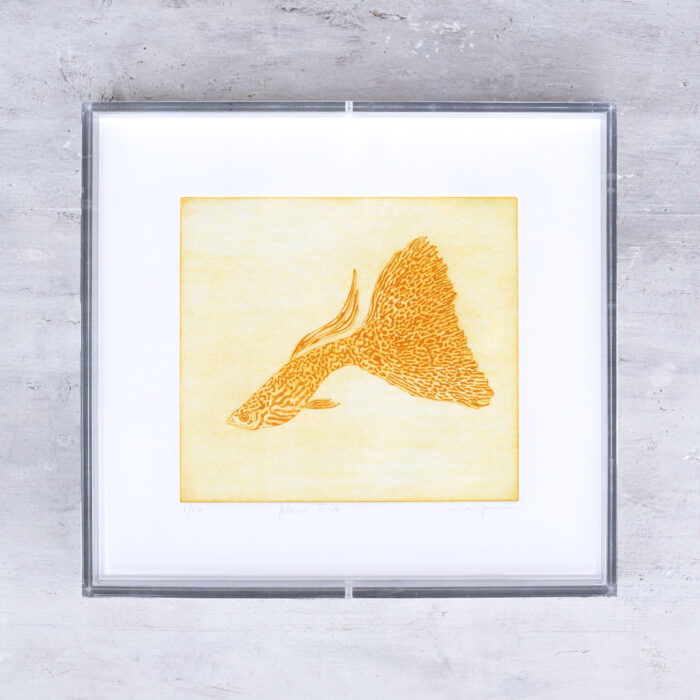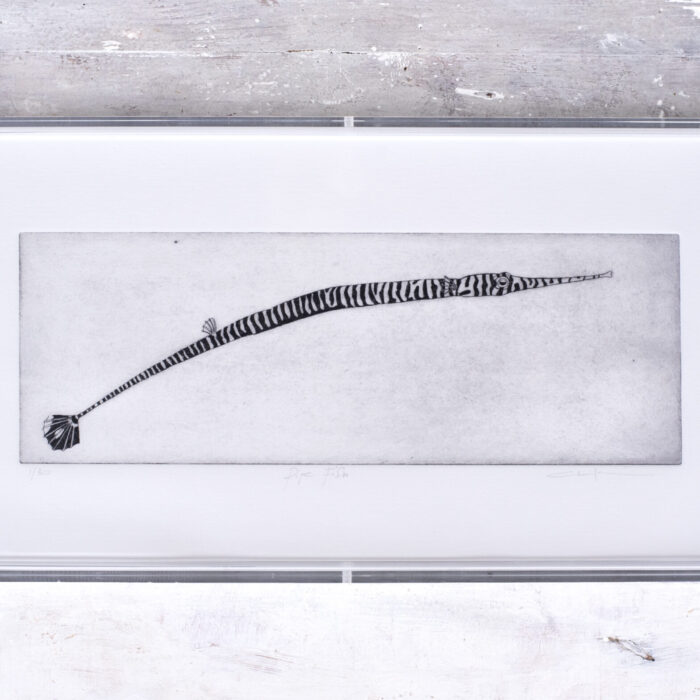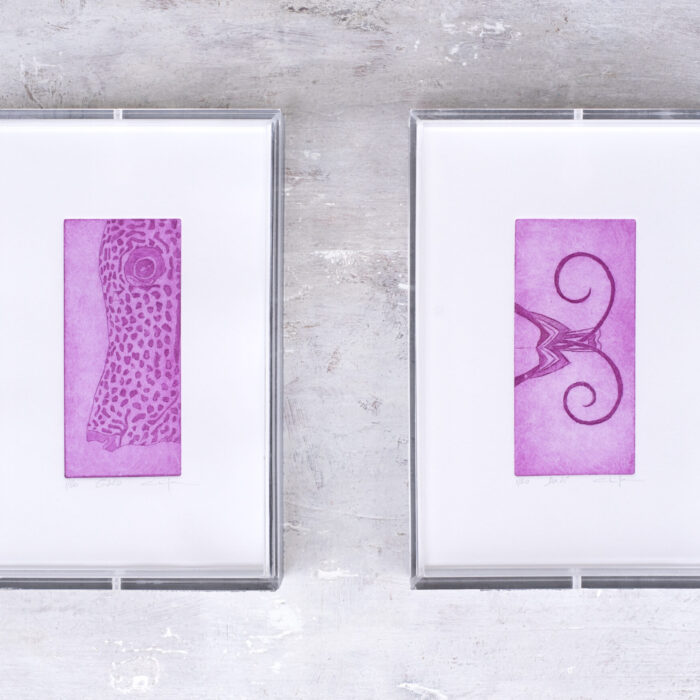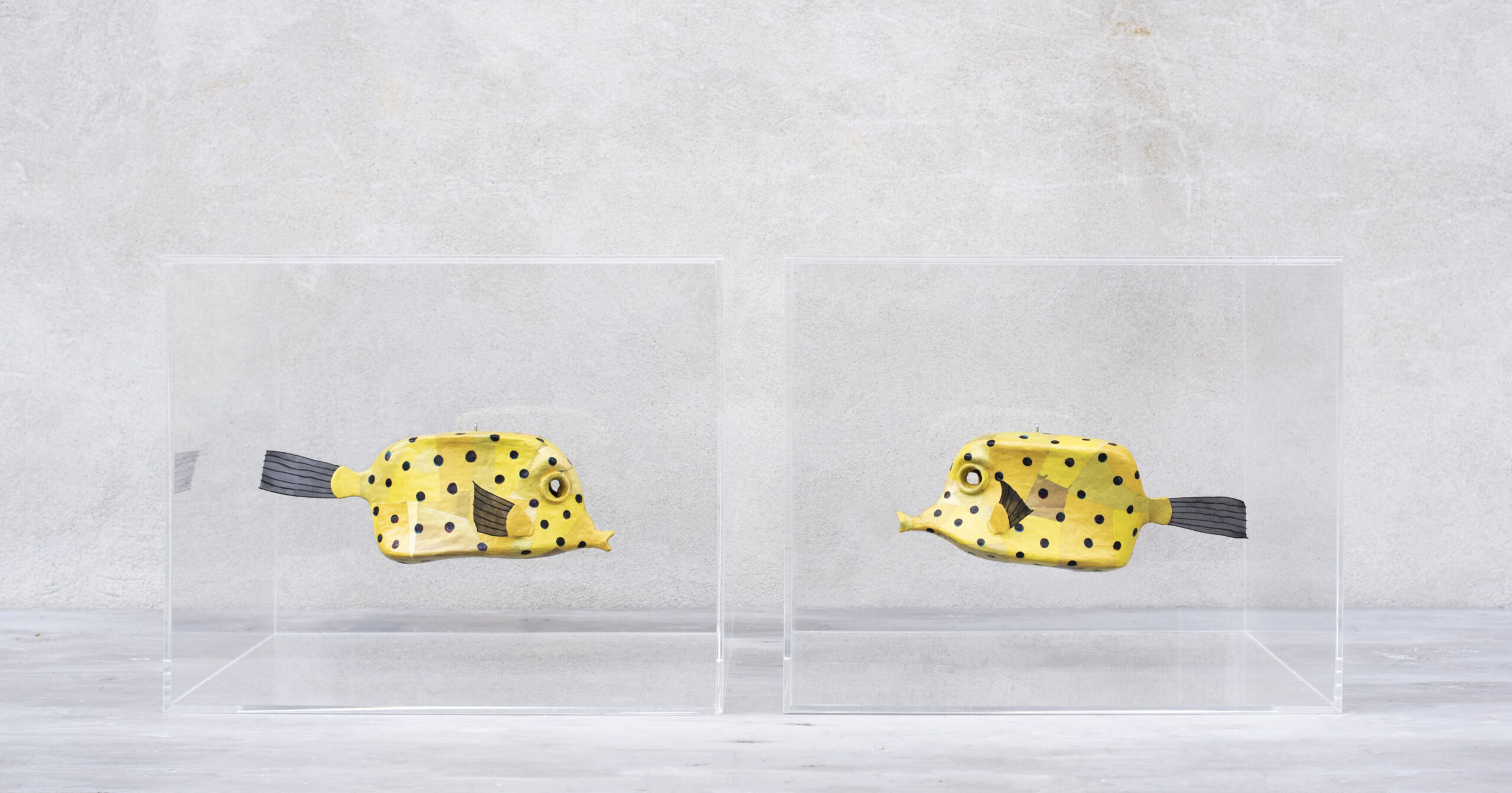
YELLOW SUBMARINE#1 + YELLOW SUBMARINE#2, 2022, cartapesta, tessuto, filo, resin, acrilico, plexiglass/ papier-mâché, fabric, thread, resin, acrylic, perspex box, cm 31x38x38 + cm 31x38x38
I pinguini appaiono vagamente perplessi. Disposti a semicerchio intorno alla grande teca come adepti di fronte a un altare, allungano i colli per spiarne il contenuto: due protesi mammarie piene di silicone.
Alice Zanin non è nuova all’ironia di sapore dada. In passato aveva sospeso elefanti su installazioni geometriche fatte di noccioline americane, oppure aveva posto un’antilope rosa in bilico su una sedia a sua volta appoggiata con una gamba a un mucchio di nidi d’uccello. Il nonsense al cuore di questa installazione (Penguin colony takes implants for ice packs), tuttavia, possiede un retrogusto amaro. La levigata verosimiglianza degli animali in cartapesta – che sembrano colti proprio nel mezzo di quel loro inconfondibile passo ondeggiante – e l’eleganza un po’ retrò che contraddistingue da sempre il lavoro dell’artista piacentina, non riescono a celare il cortocircuito tra natura e artificio, l’ossimoro inconciliabile che oramai ci risuona nelle orecchie ogni giorno. L’ansia con cui i pinguini osservano quegli oggetti alieni sperando di potervi rintracciare un po’ di ghiaccio (ancorché secco) ci riporta all’allarme acqua e a quel monito verso la salvaguardia del pianeta che oramai non possiamo dimenticare mai: dalla mattina quando ci laviamo i denti alla sera, quando carichiamo la lavastoviglie.
PENGUIN COLONY TAKES IMPLANTS FOR ICE PACKS, 2017, cartapesta, resina, vetro, acciaio, vasca d’acquario di riciclo, protesi mammarie in silicone/ papier-mâché, resin, glass, steel, recycled aquarium tank, silicone breasts implants, cm 69x130x67
Eppure è sempre la grazia a vincere nel lavoro di Alice Zanin. Una grazia che alle suggestioni dada della grande installazione con i pinguini affianca le sinuosità Liberty che da tempo abbiamo imparato ad amare nelle sue sculture e un’estetica dai colori pop che, in realtà, non è frutto di un lavoro di fantasia dell’artista ma dei guizzi evolutivi e mimetici della natura: quelli che vedete in mostra sono proprio i colori reali degli animali ritratti.
Giallo acceso a piccoli pois neri è in natura l’Ostracion cubicus, un pescione di quasi mezzo metro che si è meritato il soprannome di “pesce scatola” grazie alla sua forma vagamente geometrica (un musetto grazioso con la bocca a trombetta di cui è meglio non fidarsi, visto che è velenoso); e ancora a pois – ma questa volta un bel gioco optical di pallini bianchi su fondo nero – è il manto della Narinari, la razza aquila, che l’artista dispone a pinne spiegate, in una posizione quasi di decollo, riuscendo a renderne la maestosa fierezza. Poi c’è il Pesce chirurgo blu (Paracanthurus hepatus) con il contrasto della coda e delle pinne gialle che ne fanno un dipinto astratto di Sonia Delaunay. E ancora la Chromodoridoidea, una lumaca di mare che in quell’intarsio di azzurri, lilla e aranci sembra generata da una delle Nana di Niki de Saint Phalle.
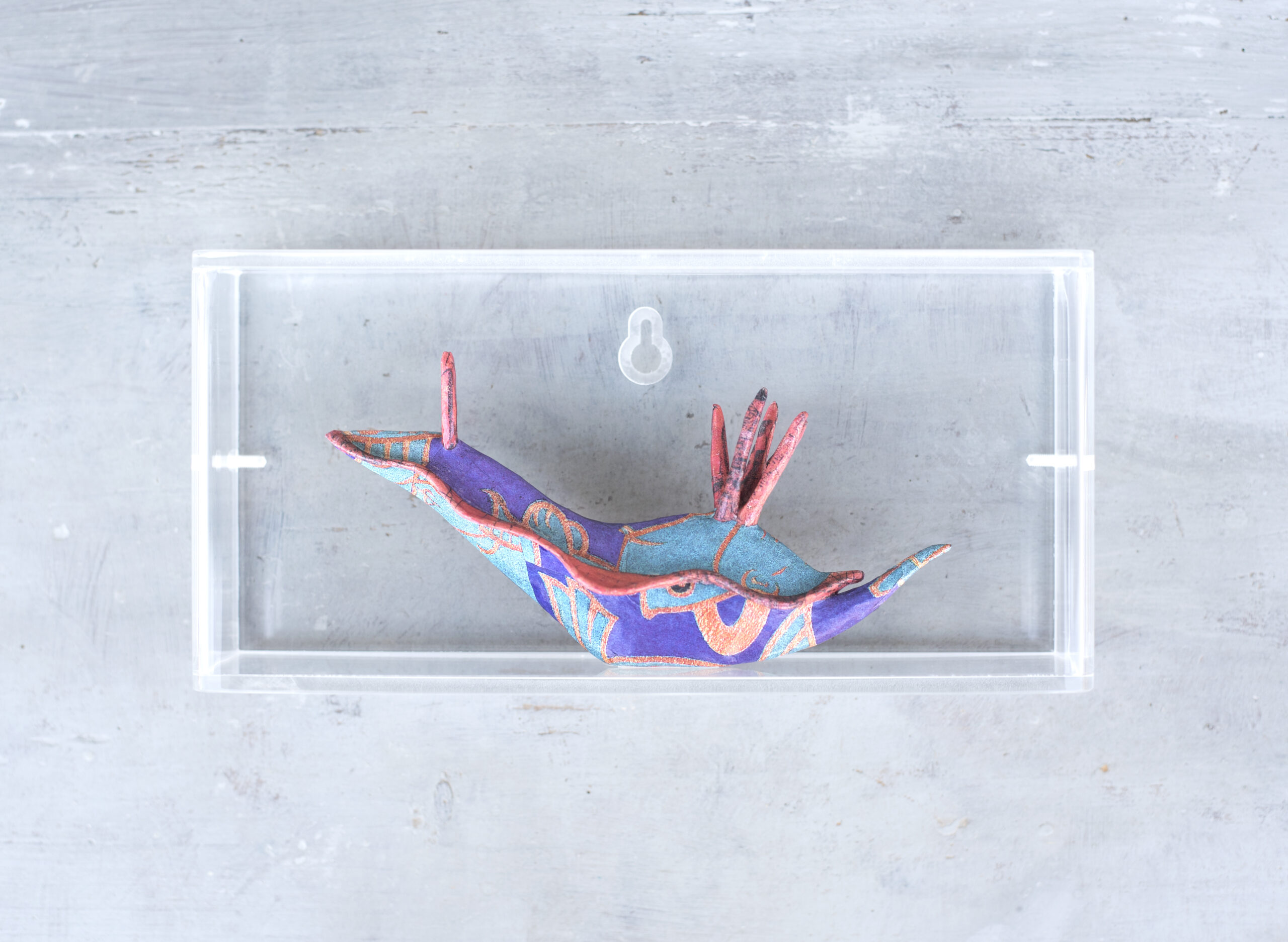
CHROMODORIDOIDEA#1, 2023, cartapesta, resina, plexiglass/ papier-mâché, resin, perspex box, cm 10×20,7×5,6
Un incursione negli abissi che ci costringe di tanto in tanto a venire a patti con la realtà quando incontriamo gli animali sotto teca, improvvisamente inermi, come congelati nella loro bellezza. Accade al Weedy, il dragone del mare – figura fatata e danzante il cui corpo sinuoso fluttua decorato da pinne leggere, attaccate al tronco come fragili foglie – e all’Hippocampus minor, grande scultura di un intenso blu Klein per la quale l’artista tradisce la cartapesta scegliendo il bronzo patinato.
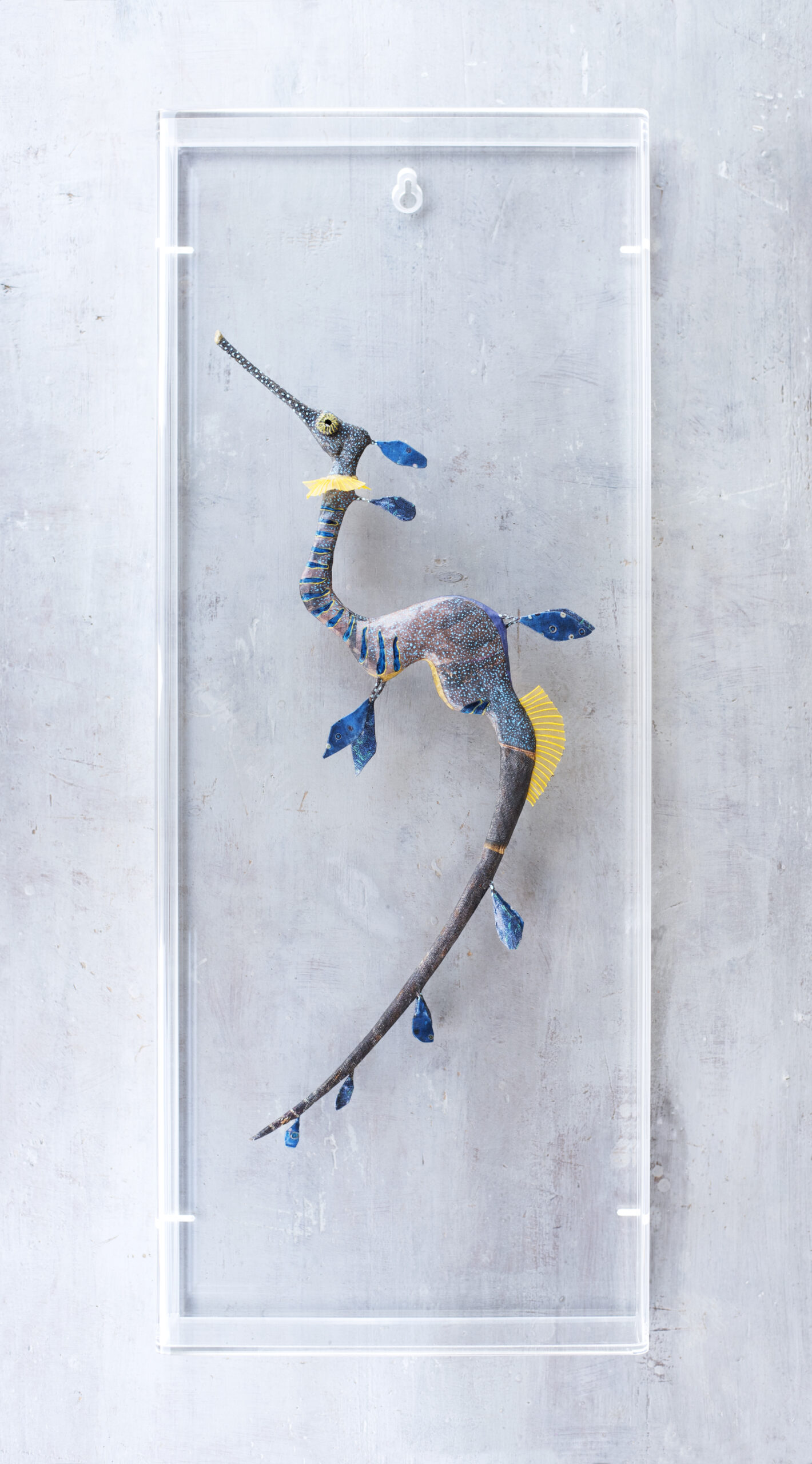
WEEDY, 2022, cartapesta, tessuto, filo, resina, plexiglass/ papier-mâché, fabric, thread, resin, perspex box, cm 52,1×20,7×5,6
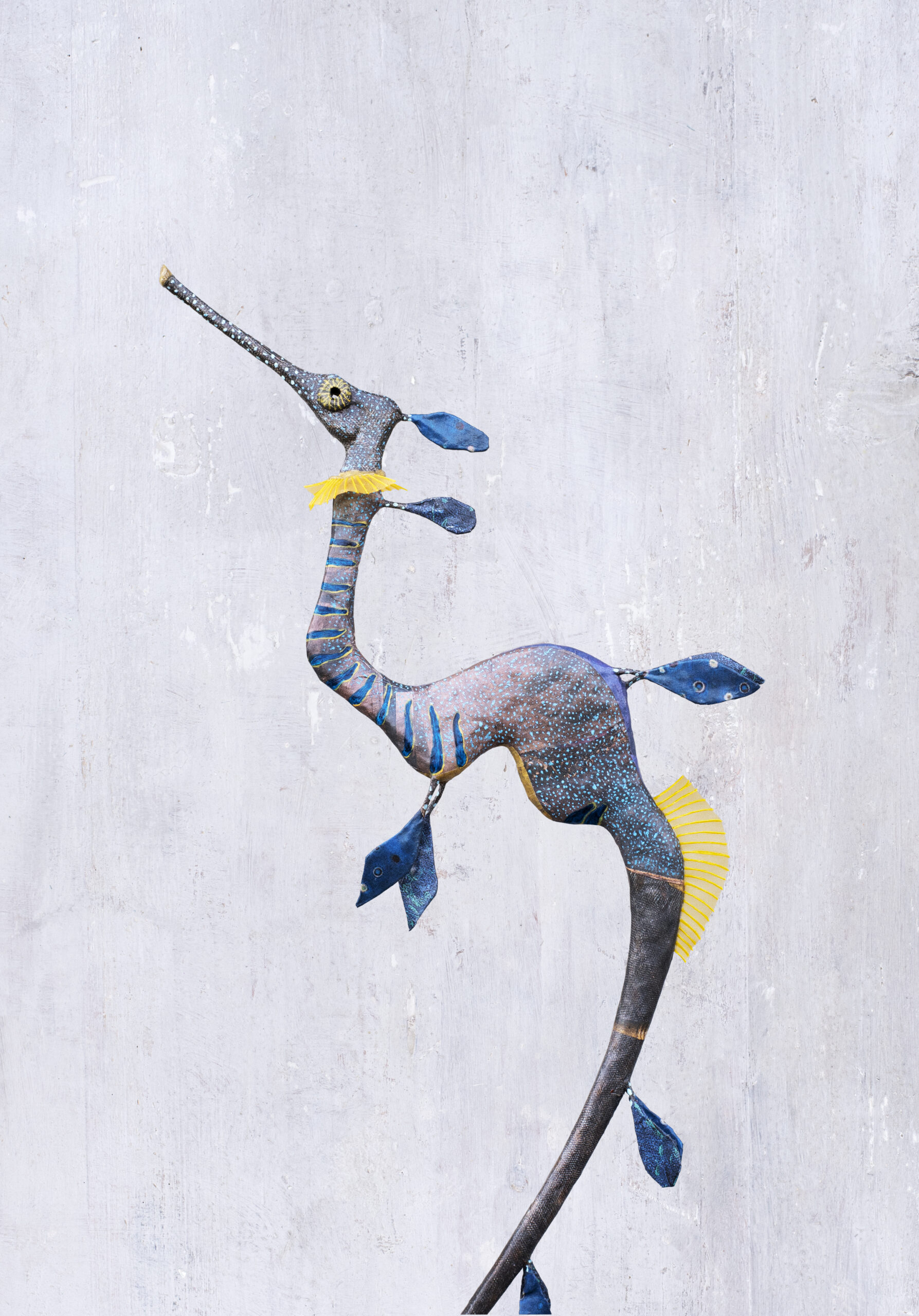
WEEDY, 2022, cartapesta, acrilico, tessuto, filo, resina, plexiglass/ papier-mâché, acrylic, fabric, thread, resin, perspex box, cm 52,1×20,7×5,6, part.
Quella che Alice Zanin ingaggia con lo spettatore è una sfida concettuale sottilissima e raffinata, tutta giocata sul punto di equilibrio tra realtà e artificio, tra logica e assurdo. Non solo nella simbologia abbastanza esplicita che abbiamo raccontato più sopra, con i pinguini che scambiano delle protesi mammarie (simbolo di un’artificiosità che arriva a intaccare persino il nostro corpo e tuttavia, al tempo stesso, anche supporti medici dalle profonde valenze psicologiche), ma anche nel suo condurre la ricostruzione dell’animale sempre sul filo della possibilità. I colori sono reali, è vero, l’abbiamo detto, ma accuratamente scelti per suonare al nostro cervello come qualcosa di fantastico, per instillarci il dubbio. E anche le forme, le proporzioni, per quanto fedeli e precise, virano sempre impercettibilmente all’allungamento, alla rastremazione, alla rarefazione, fino a sfondare la soglia del sogno.
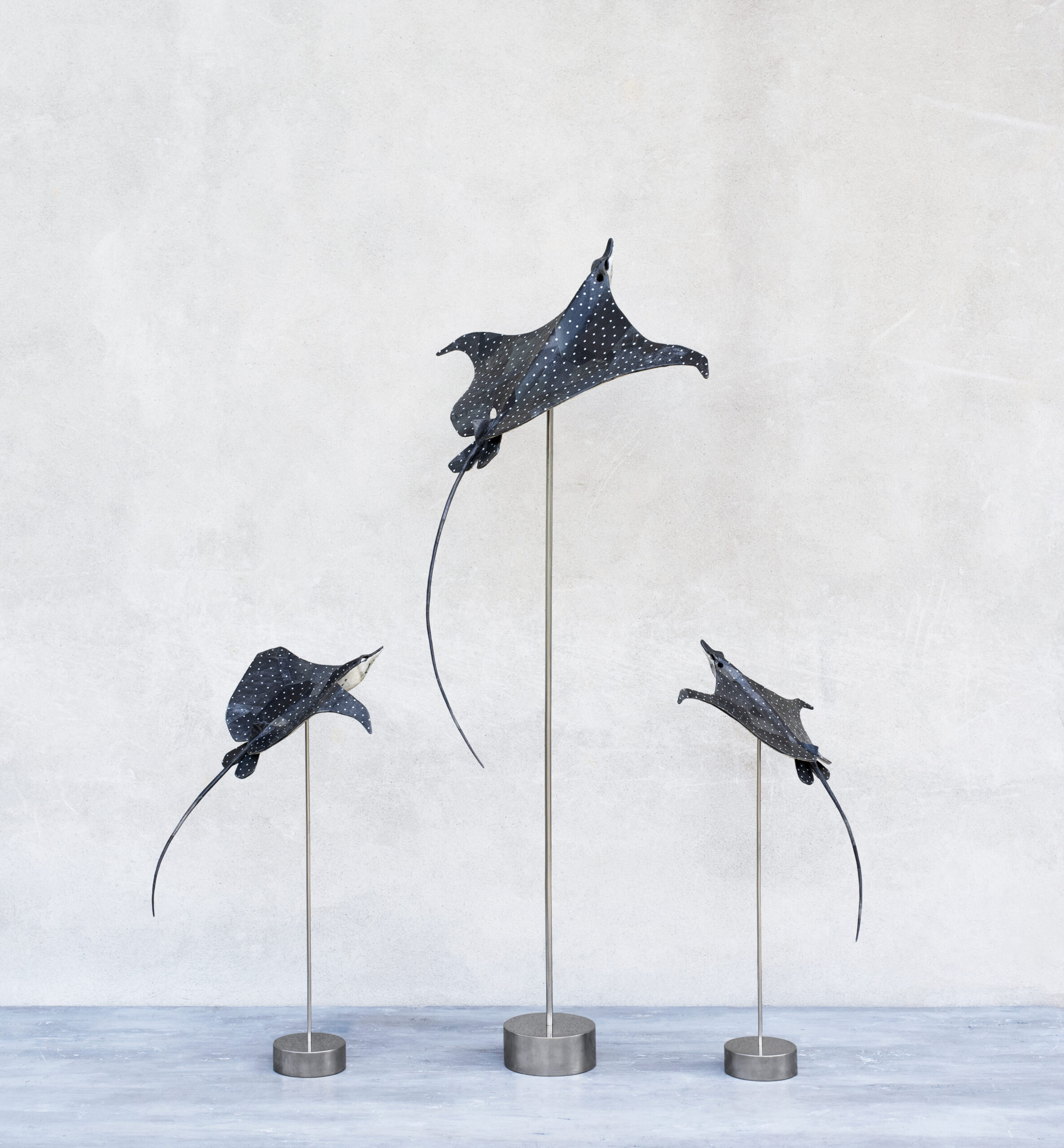
NARINARI#1 + NARINARI#2 + NARINARI#3, 2023, cartapesta, acrilico, acciaio/ papier-mâché, acrylic, resin, steel, cm 126,5x52x67,5 + cm 65,4x40x45,5 + 66,5×45,5×43,5
Accade in tutte le sue sculture, belle come il volto di Nefertiti che ogni volta ci lascia il dubbio sull’esistenza reale di una donna con un viso così perfettamente cesellato. E accade anche nelle acqueforti, dove gli evanescenti Dragoni foglia, i calamari, le razze, i pesci pipa e il sontuoso Million Fish, con quella pinna caudale ampia come un abito da sera, fluttuano in un mare declinato a colori pastello. E dove – ancora – Alice Zanin ci regala un inganno percettivo, applicando ad alcune delle opere una piccola lente in grado di riprodurre l’effetto di rifrazione dell’acqua.
Submarines & Periscopes di Alessandra Redaelli
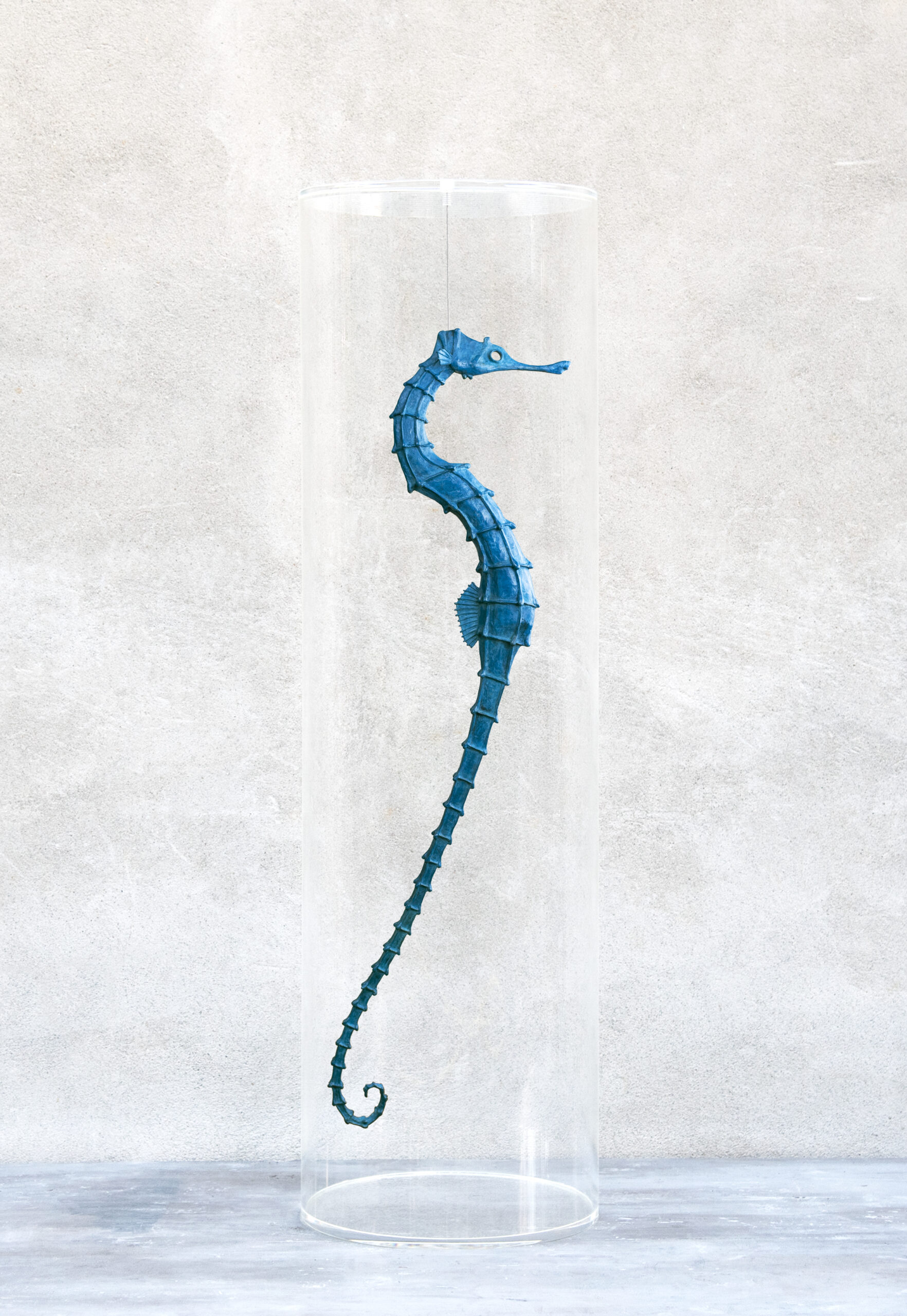
HIPPOCAMPUS MINOR 3/9, 2022, bronzo patinato, plexiglass, acciaio/ patinated bronze, perspex cylinder, steel, cm 103×30ø
The penguins appear vaguely perplexed. Arranged in a semicircle around the large display case like disciples in front of an altar, they stretch their necks to spy on its contents: two breast implants filled with silicone.
Alice Zanin is not new to the irony of Dada. In the past she suspended elephants from geometric installations made from peanuts, or perched a pink antelope on a chair which in turn leaned with one leg on a pile of birds’ nests. The ‘nonsense’ at the heart of this installation (Penguin colony takes implants for ice packs), however, has a bitter aftertaste. The polished verisimilitude of the papier-mâché animals – who seem caught right in the middle of their unmistakable swaying step – and the slightly retro elegance that has always distinguished the work of the Piacenza artist, cannot conceal the short-circuit between nature and artifice, the irreconcilable oxymoron that now rings in our ears every day. The anxiety with which the penguins observe those alien objects hoping to be able to track down a bit of ice (albeit dry) brings us back to the water alert and to that warning about the protection of the planet that by now we can never forget: from the morning when we brush our teeth, to the evening, when we load the dishwasher.
Yet it is always grace that wins in Alice Zanin’s work. A grace that juxtaposes the Dada suggestions of the large penguin installation with the sinuosities of Art Nouveau that we have long since learned to love in her sculptures and a pop colour aesthetic which, in reality, is not the result of the work of the artist’s imagination but of the evolutionary and mimetic flashes of nature: the colours you see in the exhibition are the real colours of the portrayed animals.
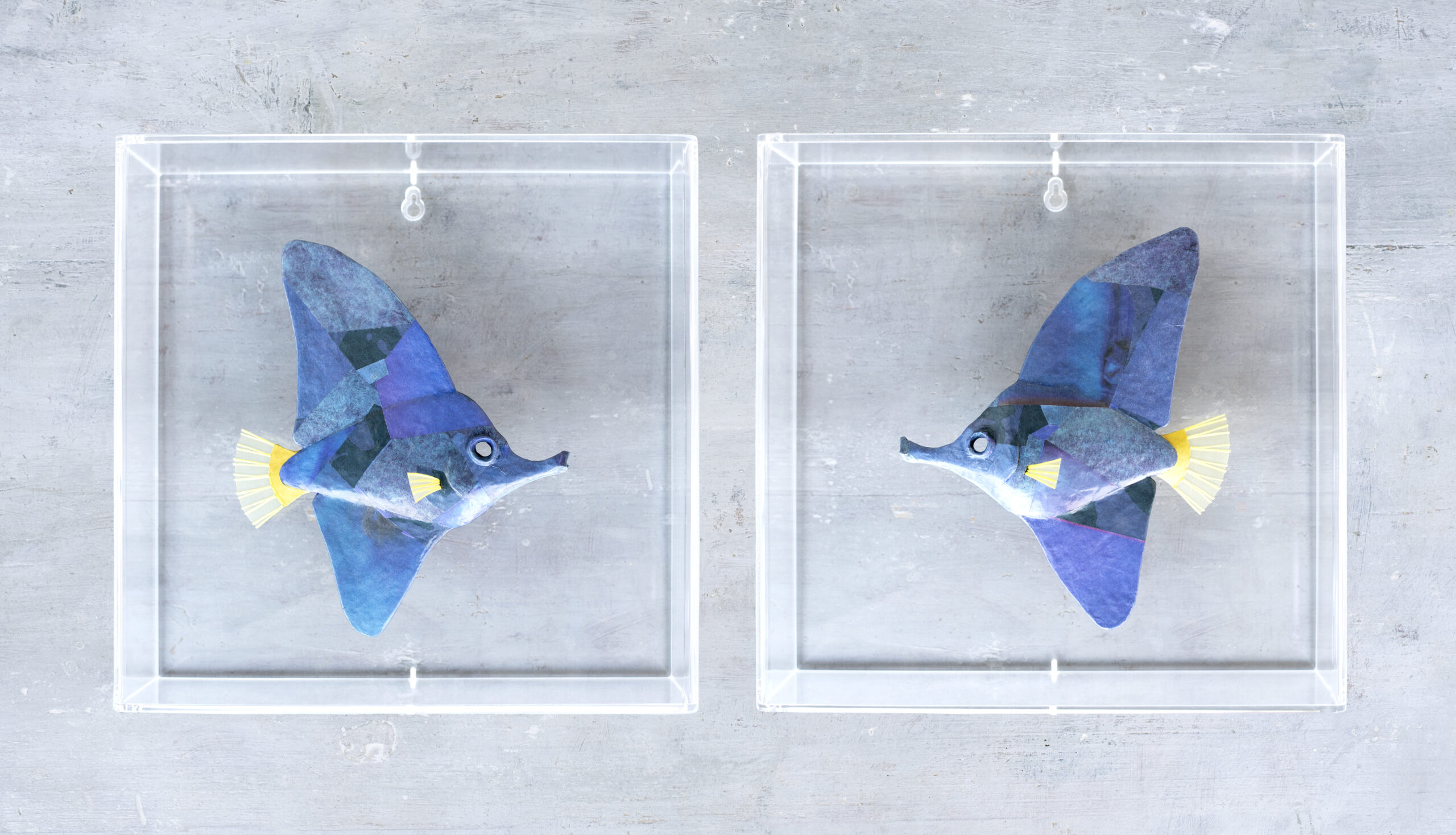
BLUE SURGEON WITH MIMOSA#2 + BLUE SURGEON WITH MIMOSA#1, 2023, cartapesta, tessuto, acrilico, filo, resina, plexiglass/ papier-mâché, fabric, thread, acrylic, resin, perspex box, cm 29,5x30x11 + cm 29,5x30x11
In nature the Ostracion cubicus is bright yellow with small black polka dots, a large fish of almost half a metre that has earned the nickname of “boxfish” thanks to its vaguely geometric shape (a lovely little face with a trumpet mouth which is better not to trust, since it is poisonous); and again in polka dots – but this time the beautiful optical play of white dots on a black background – the coat of the Narinari, the spotted eagle ray, which the artist arranges with spread fins, in a position almost of take-off, which manages to render its majestic pride. Then there is the blue surgeonfish (Paracanthurus hepatus) with the contrast of its yellow tail and fins that make it like an abstract painting by Sonia Delaunay. And also the Chromodoridoidea, a sea snail which with its inlay of azures, lilac and oranges seems to have been generated from something by Nana di Niki de Saint Phalle.
An incursion into the abysses that occasionally forces us to come to terms with reality when we meet the animals in the display case, suddenly helpless, as if frozen in their beauty. It happens to Weedy, the sea dragon – a dancing fairy-like figure whose sinuous body fluctuates, decorated with light fins which are attached to the trunk like fragile leaves – and to the Hippocampus minor, a large sculpture in an intense Klein blue for which the artist abandons papier-mâché for patinated bronze.
It is a very subtle and refined conceptual challenge that Alice Zanin engages the viewer in, all played out on the balance between reality and artifice, between logic and the absurd. Not only in the quite explicit symbology that we have described above, with the penguins mistaking the breast implants for something else (symbol of an artificiality that even affects our body and yet, at the same time, also of medical supports with profound psychological values), but also in the way she presents her reconstruction of the animal, always on the edge of possibility. The colours are real, as we said, but carefully chosen to seem to our brain like something fantastic, to instill doubt in us. And even the shapes, the proportions, however faithful and precise, always imperceptibly turn towards elongation, tapering, rarefaction, until they cross the threshold of dreams.
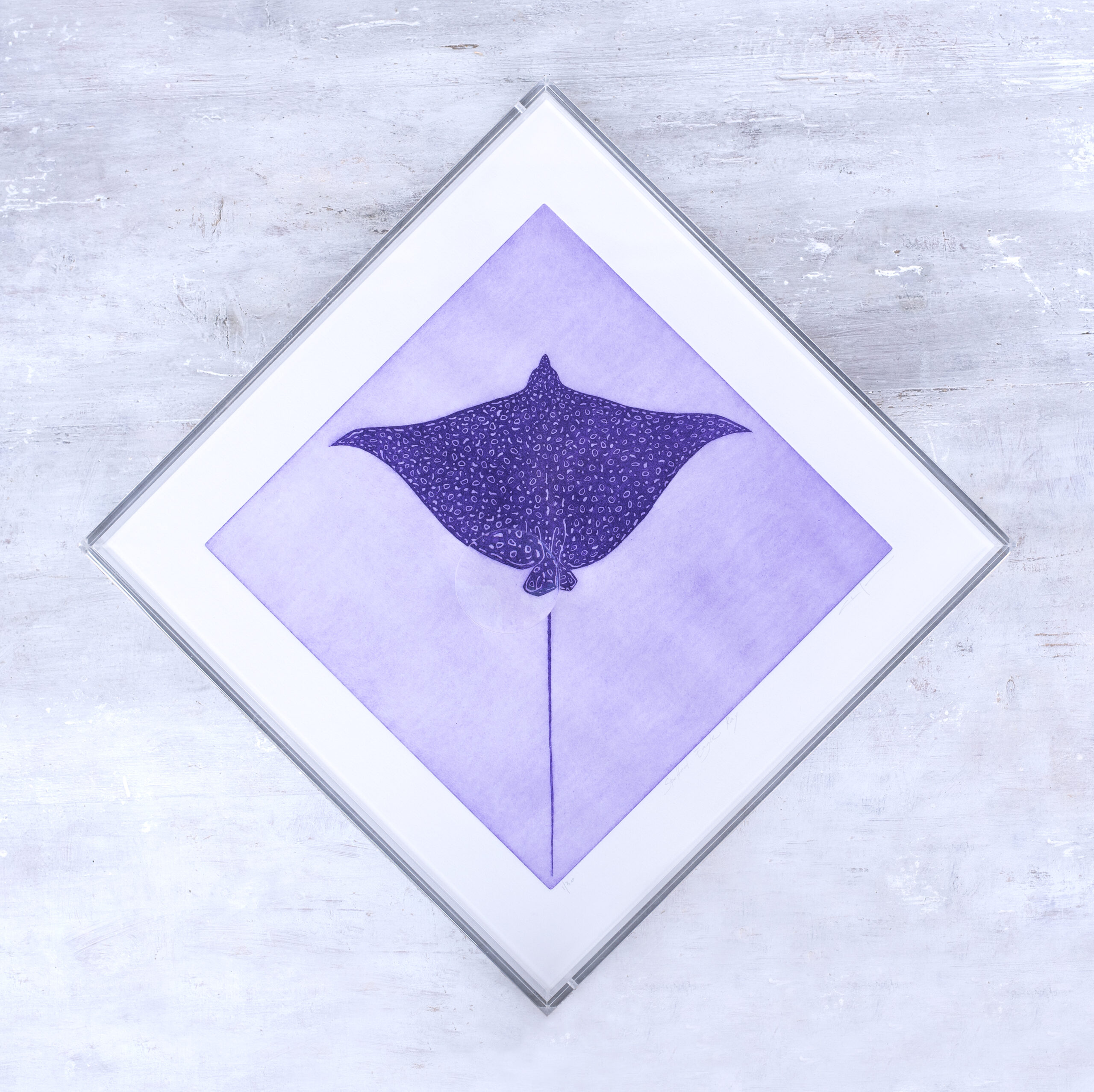
SPOTTED EAGLE RAY, 2022, acquaforte su carta Fabriano 225 g, plexiglass, lente positiva/ etching on 225 g Fabriano paper, perspex box, positive lens, cm 35,7×35,7×5, Ed 30
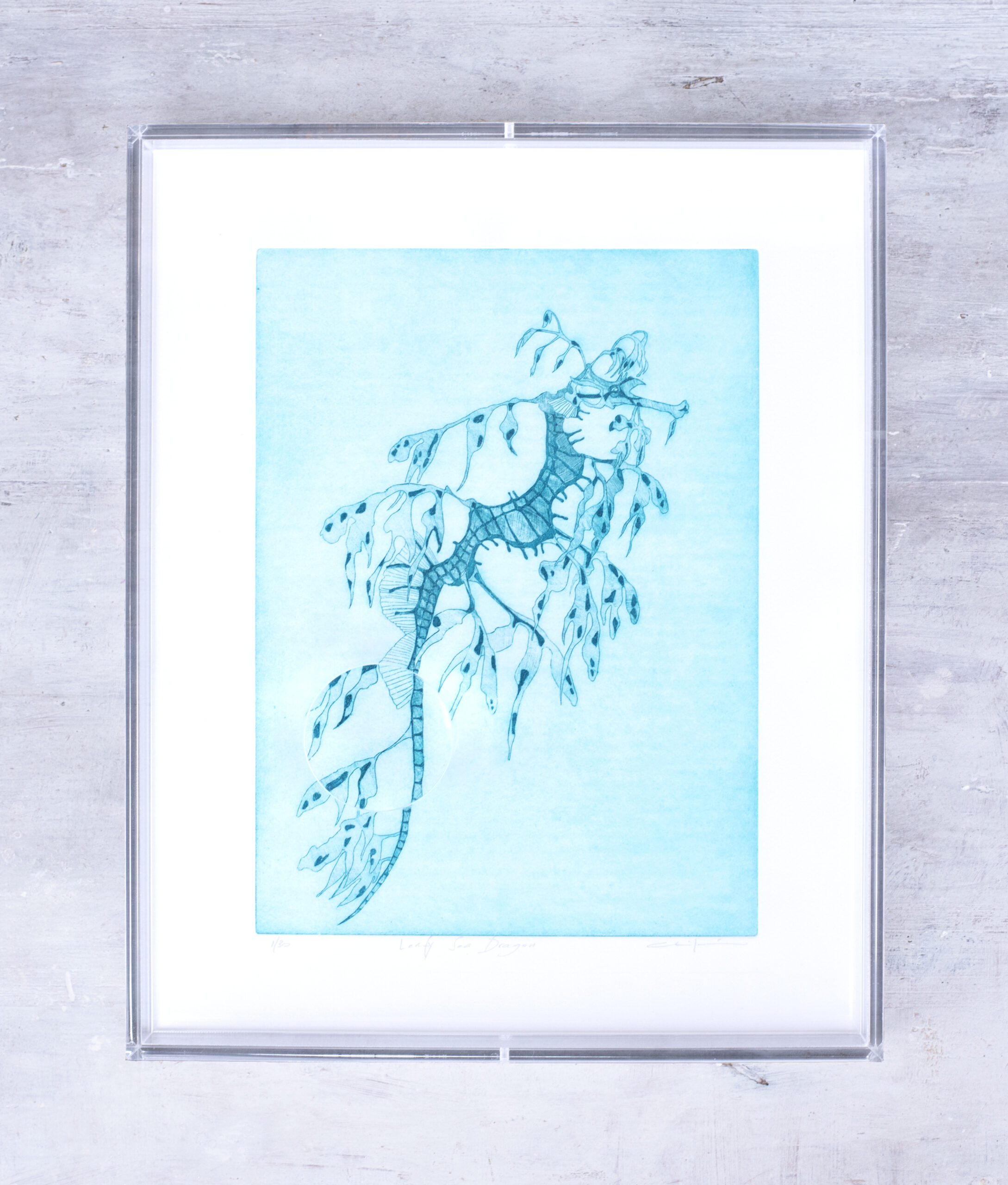
LEAFY SEA DRAGON, 2022, acquaforte su carta Fabriano 225 g, plexiglass, lente positiva/ etching on 225 g Fabriano paper, perspex box, positive lens, cm 35,8×28,6×5, Ed 30
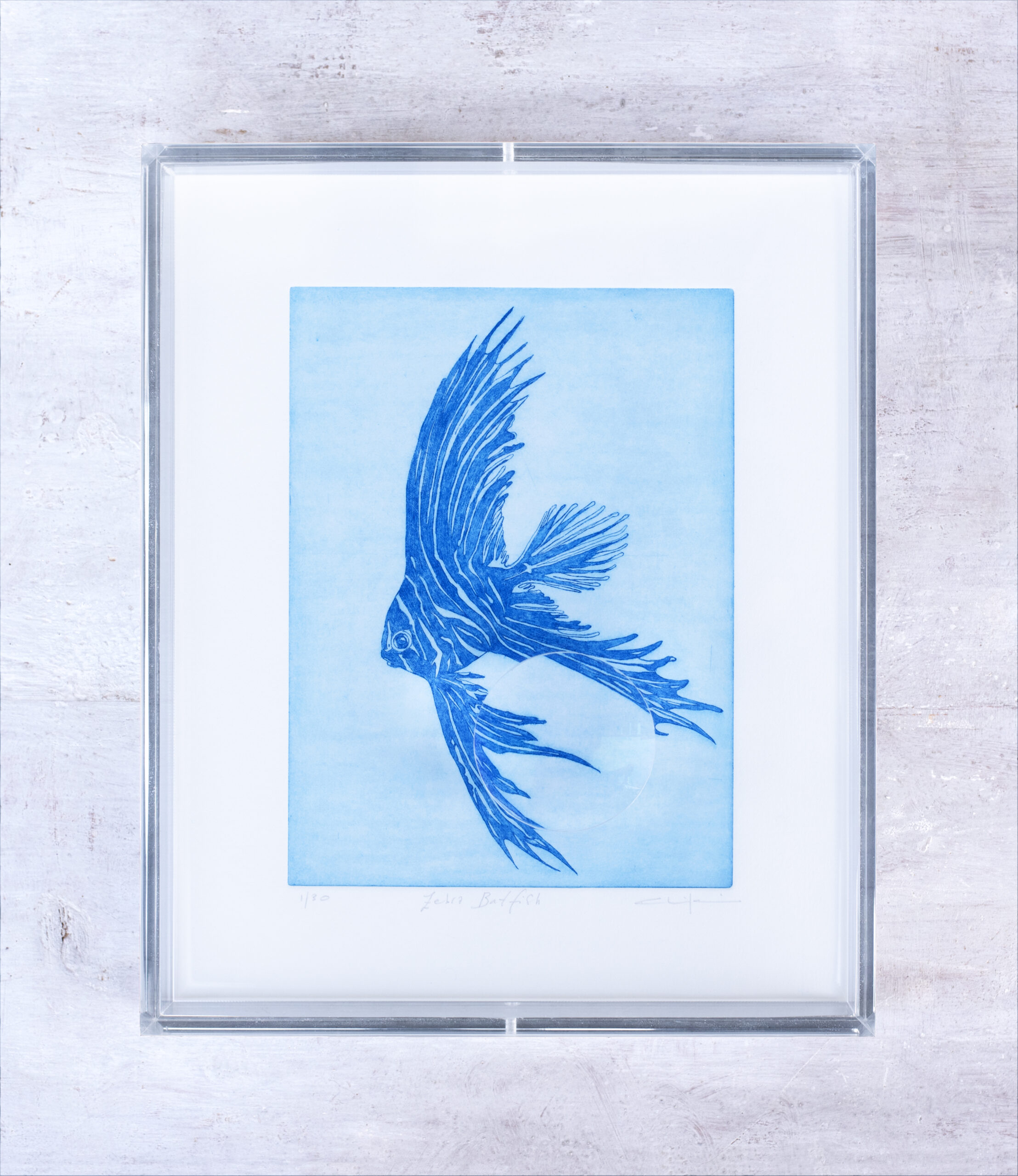
ZEBRA BATFISH, 2022, acquaforte su carta Fabriano 225 g, plexiglass, lente positiva/ etching on 225 g Fabriano paper, perspex box, positive lens, Ed 30
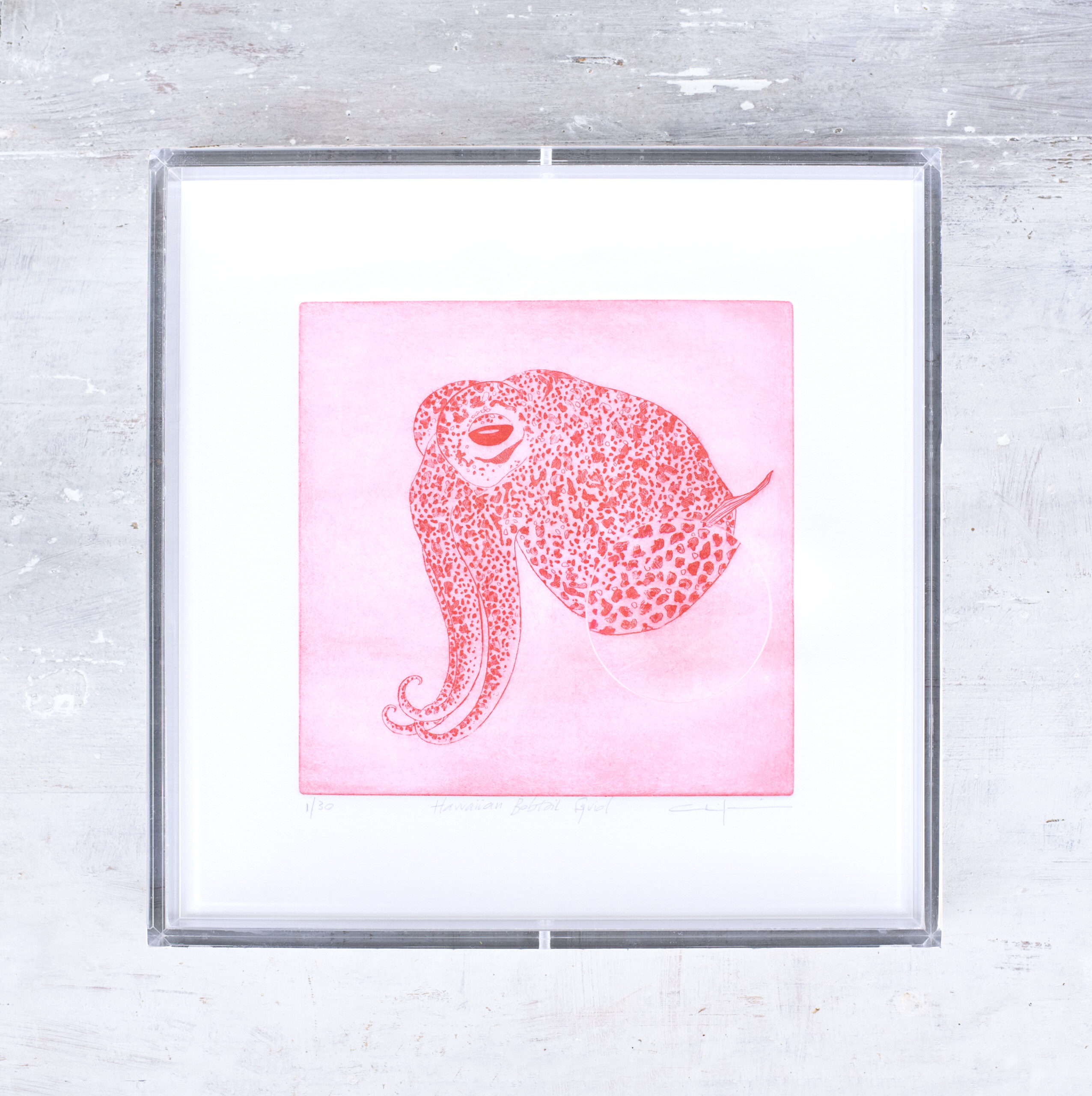
HAWAIIAN BOBTAIL SQUID, 2022, acquaforte su carta Fabriano 225 g, plexiglass, lente positiva/ etching on 225 g Fabriano paper, perspex box, positive lens, cm 24,5×24,5×5, Ed 30
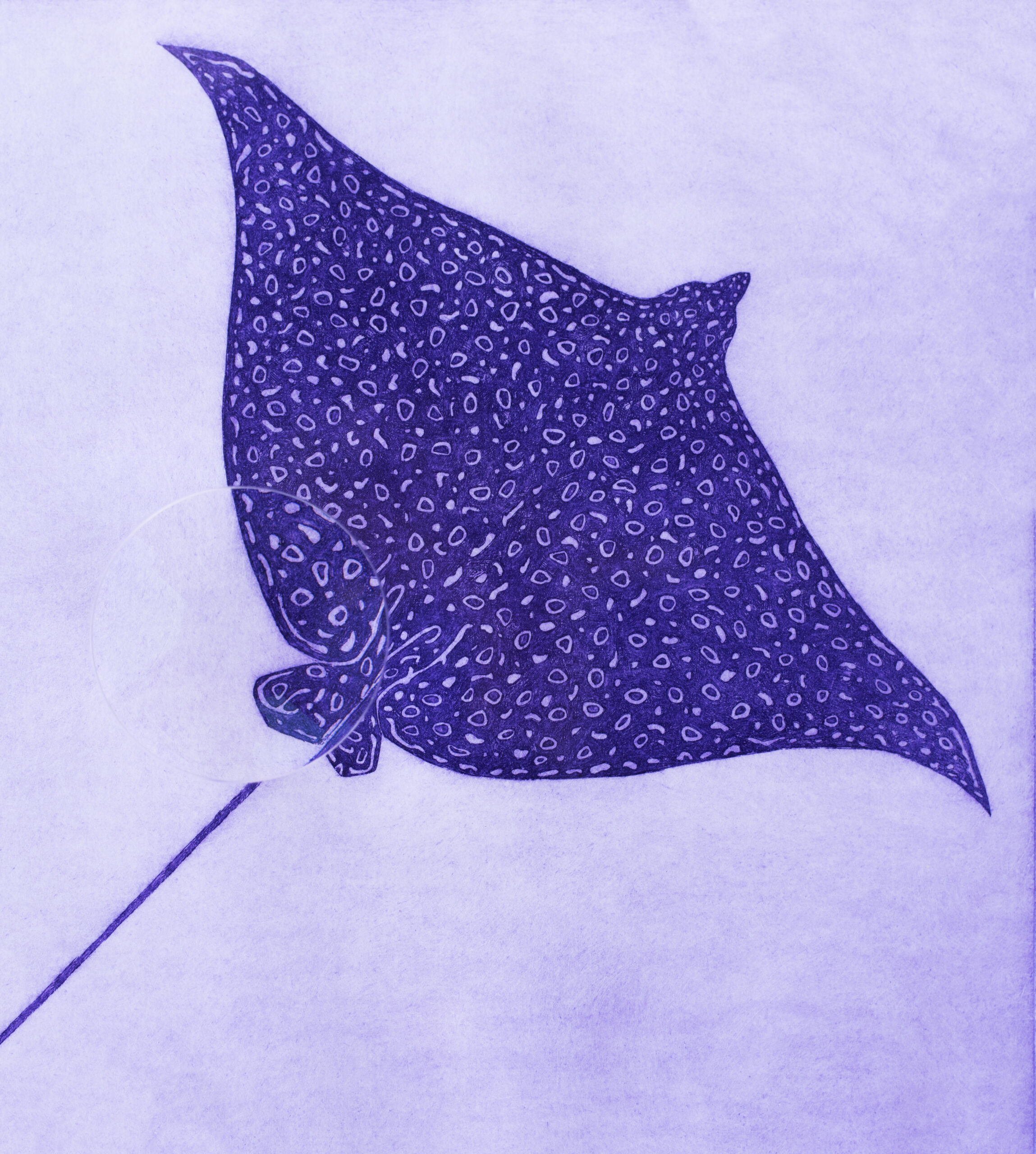 |
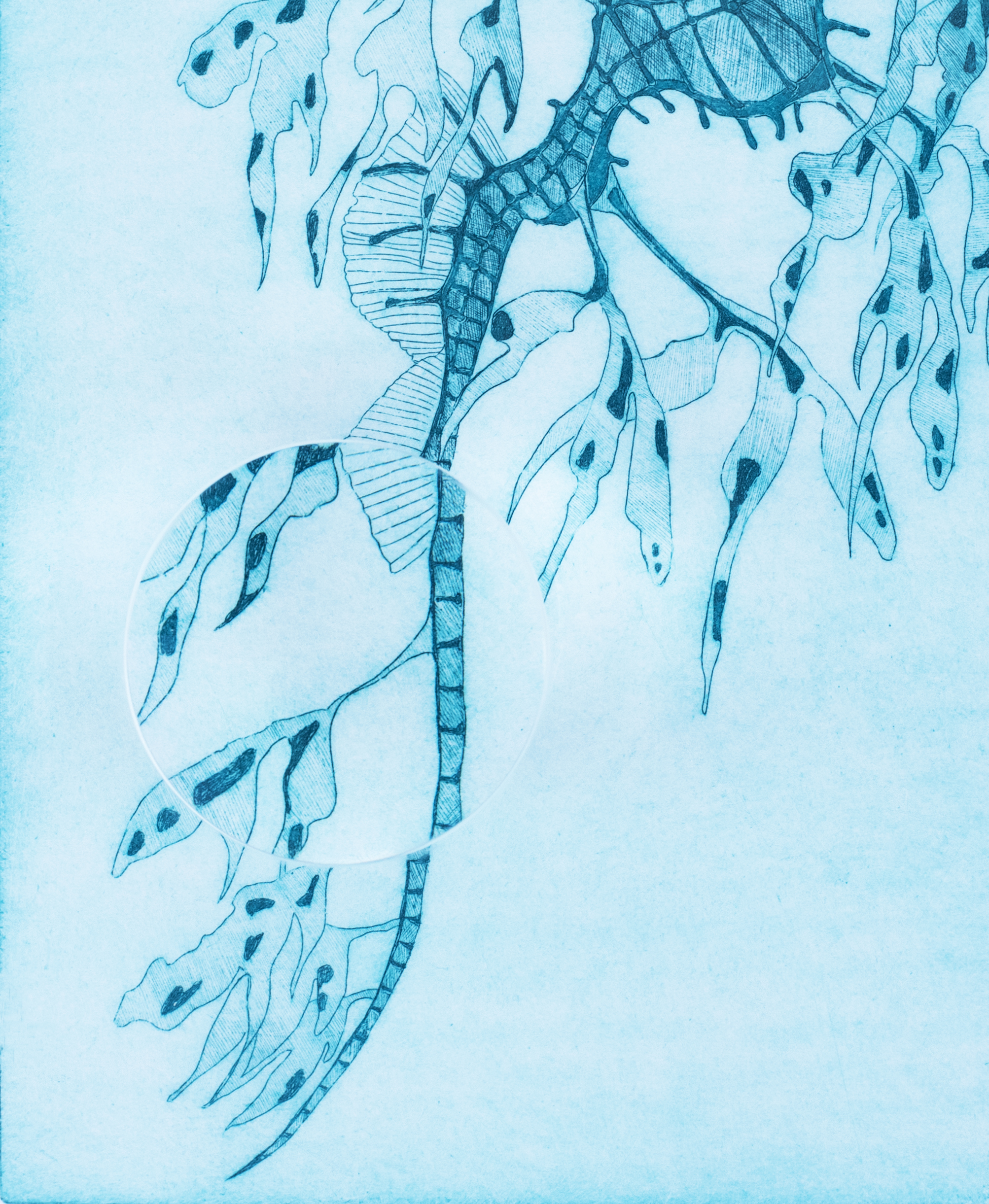 |
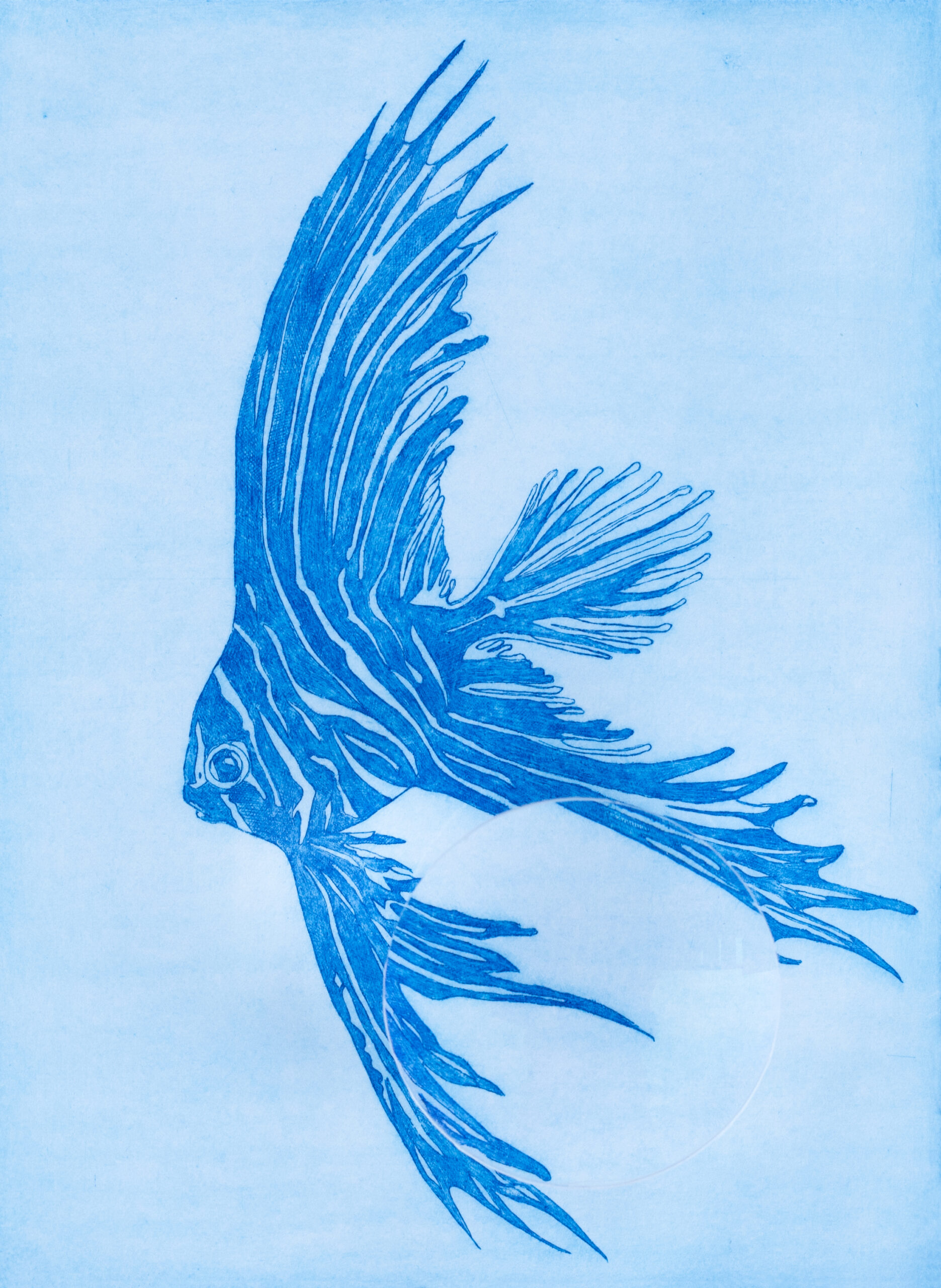 |
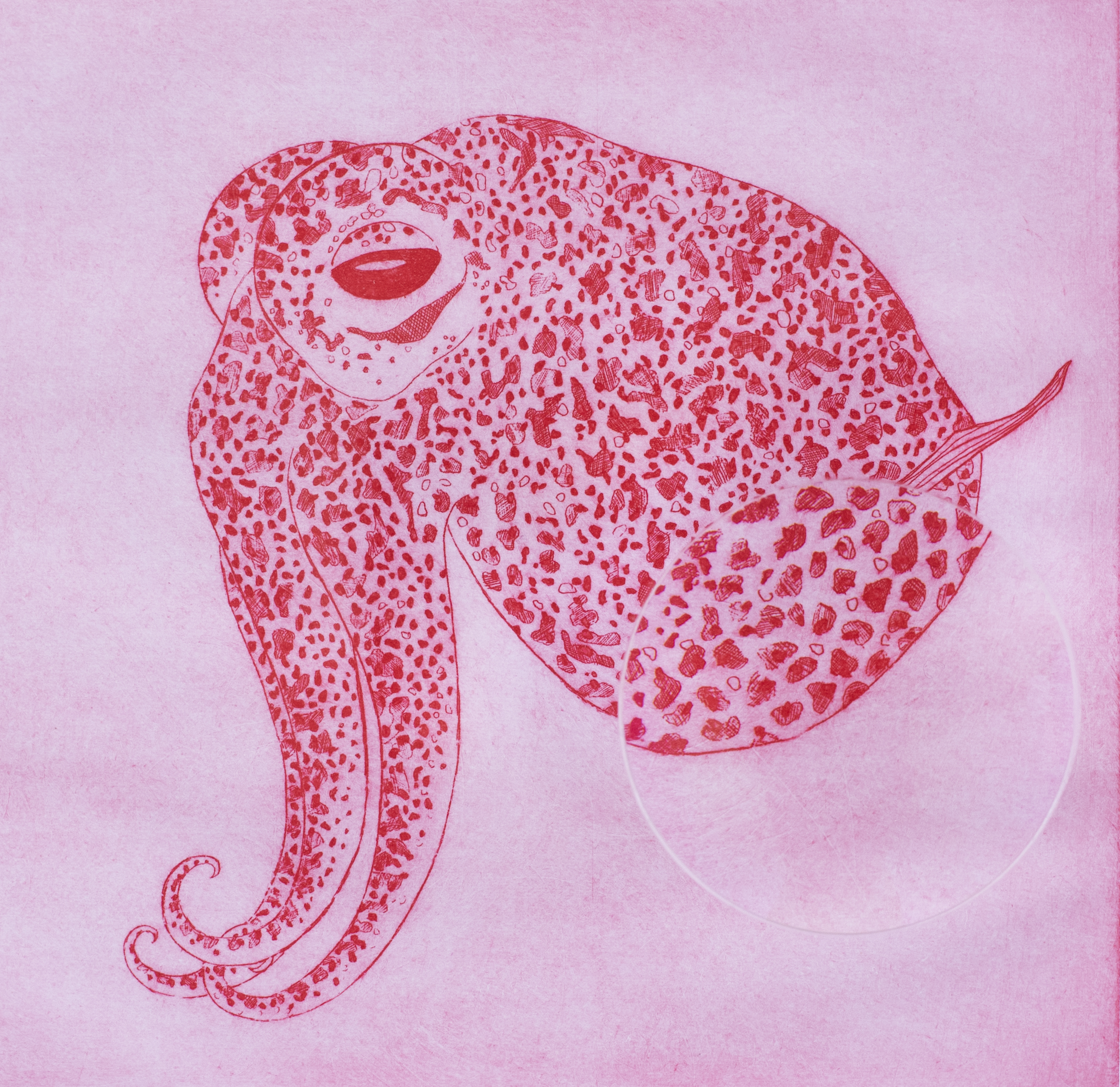 |
It occurs in all of her sculptures, beautiful like the face of Nefertiti that always leaves us doubting the actual existence of a woman with such a perfectly chiselled face. And it occurs also in her etchings, where the evanescent leaf dragons, the calamari, the stingrays, the pipefish and the sumptuous Million Fish, that, with that tail fin wide as an evening dress, float in a sea of pastel colours.
And where – again – Alice Zanin deceives our perception, applying to some of the works a small lens capable of reproducing the refraction effect of water.
Submarines & Periscopes by Alessandra Redaelli
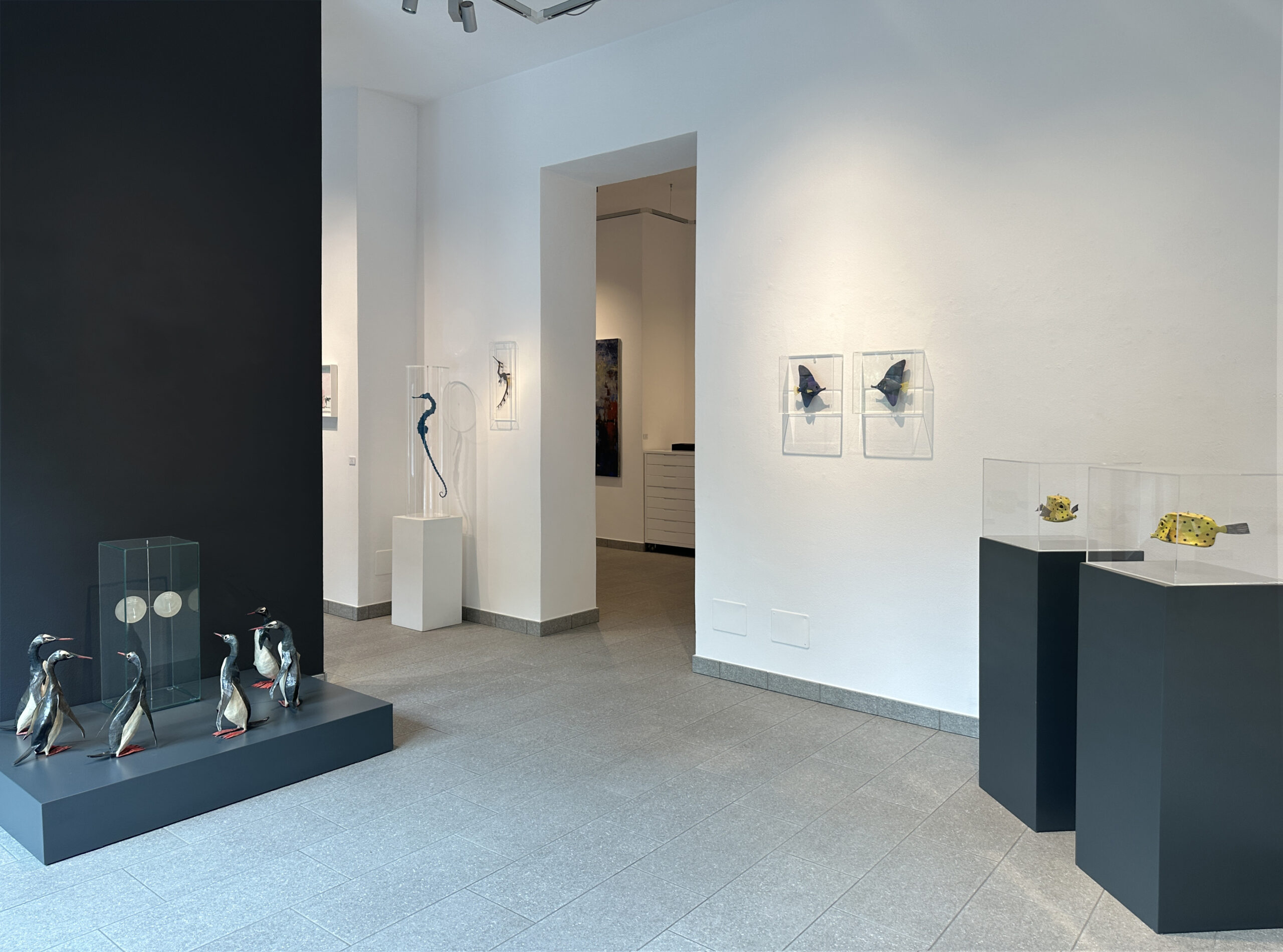
Submarines & Periscopes, veduta d’allestimento, galleria PUNTO SULL’ARTE, Varese
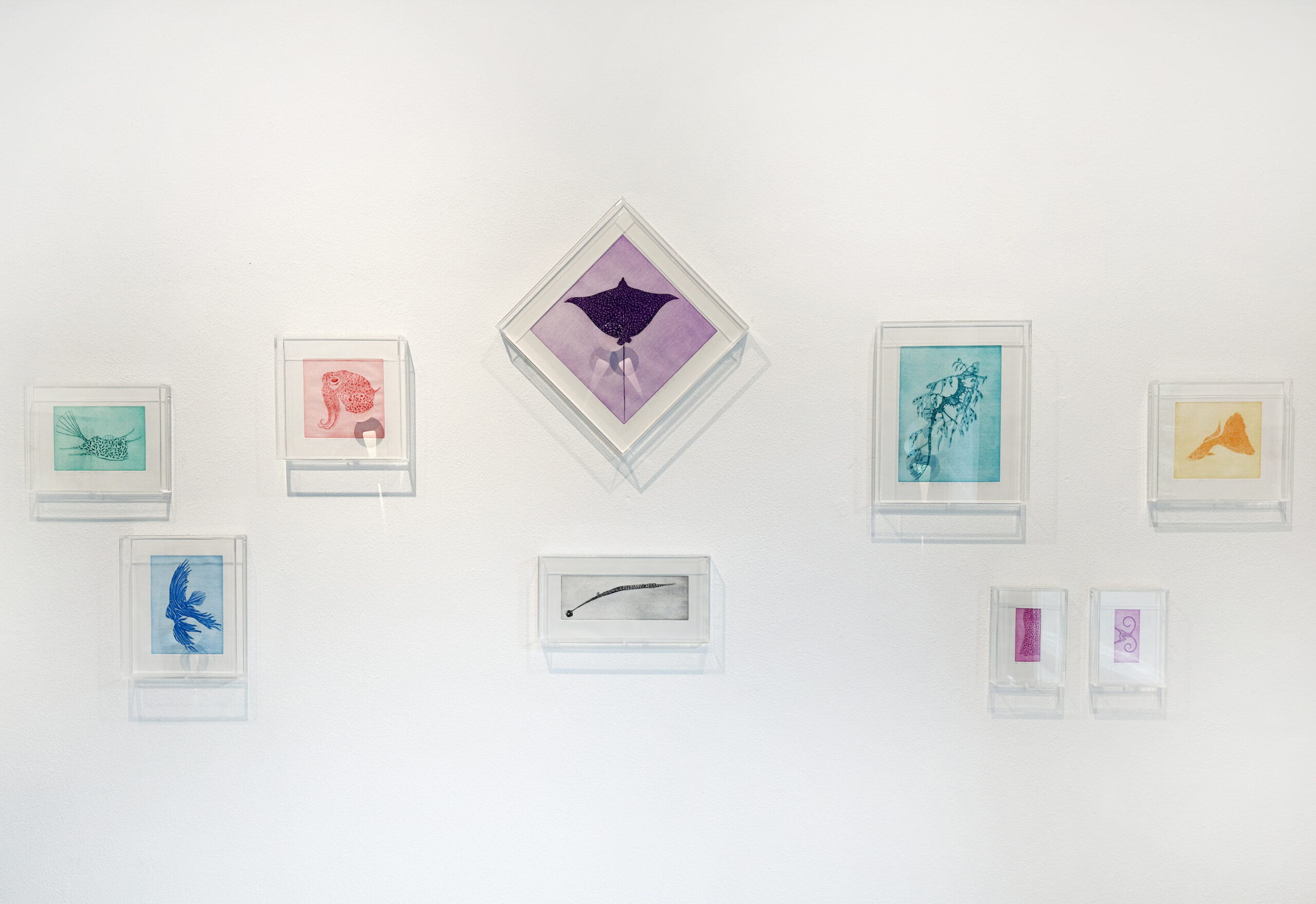
Submarines & Periscopes, veduta d’allestimento, galleria PUNTO SULL’ARTE, Varese
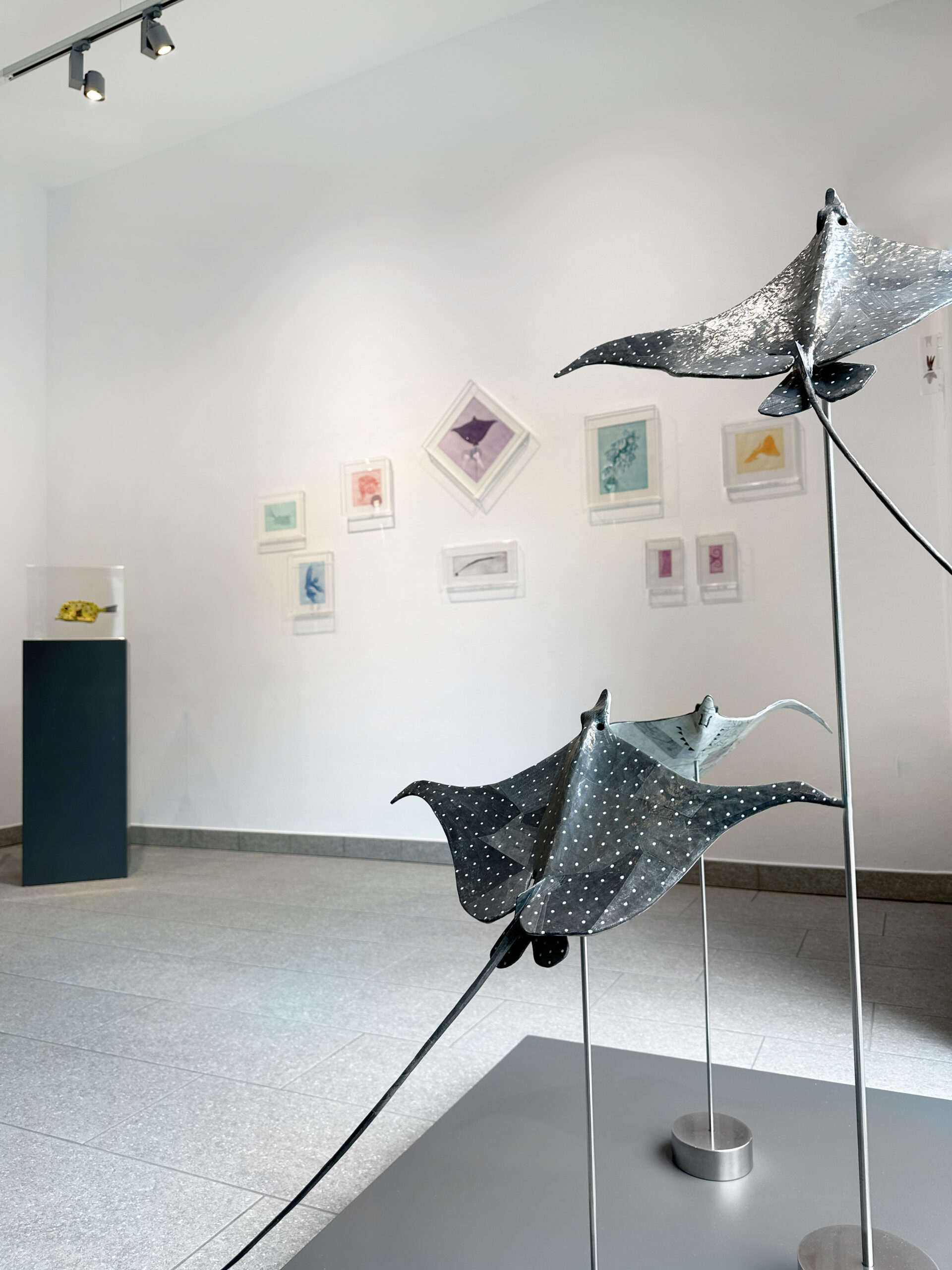
Submarines & Periscopes, veduta d’allestimento, galleria PUNTO SULL’ARTE, Varese
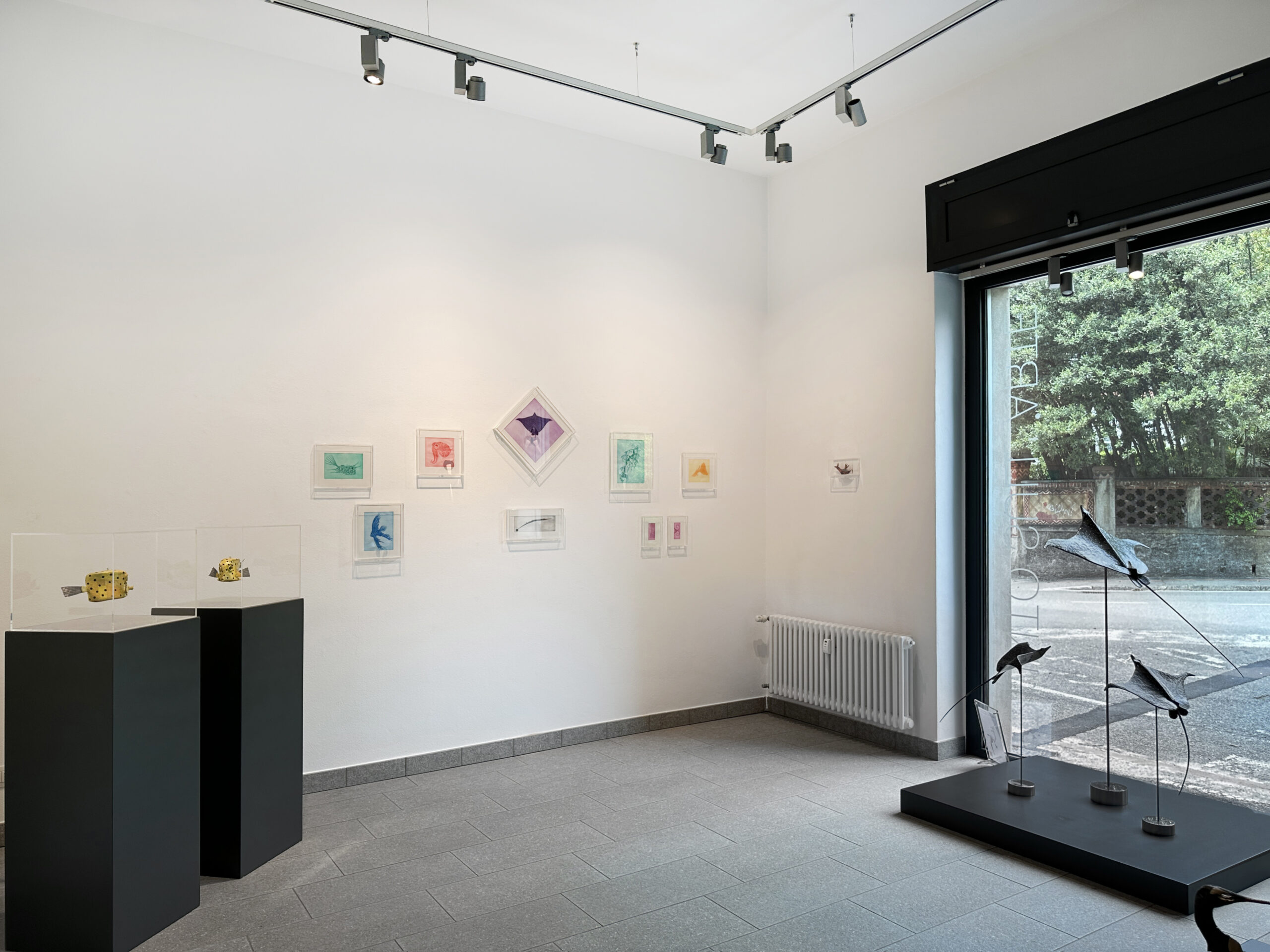
Submarines & Periscopes, veduta d’allestimento, galleria PUNTO SULL’ARTE, Varese
